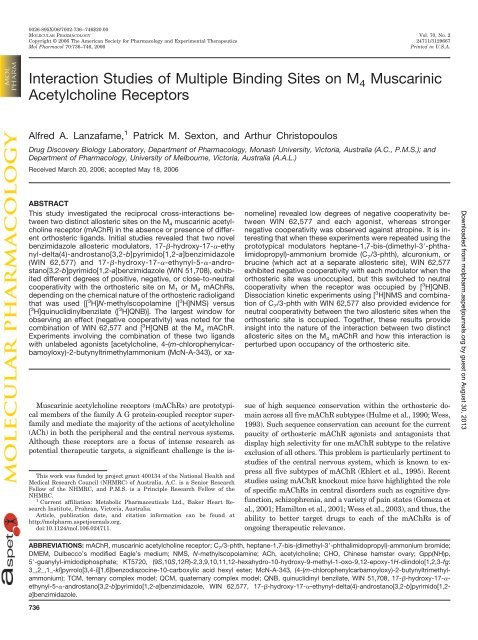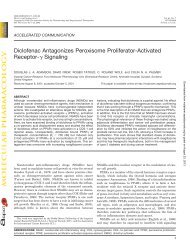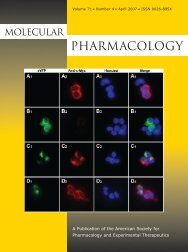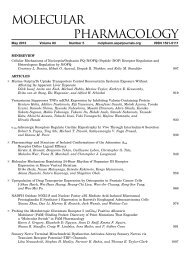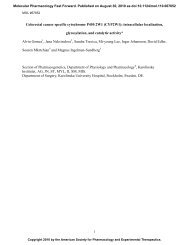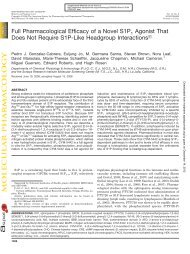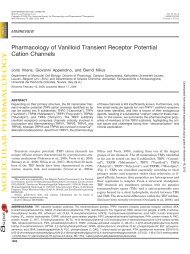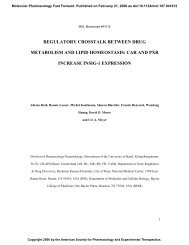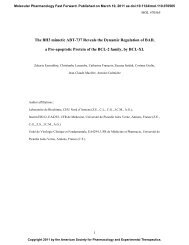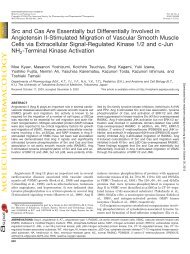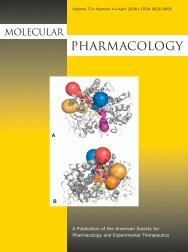Interaction Studies of Multiple Binding Sites on M4 Muscarinic ...
Interaction Studies of Multiple Binding Sites on M4 Muscarinic ...
Interaction Studies of Multiple Binding Sites on M4 Muscarinic ...
You also want an ePaper? Increase the reach of your titles
YUMPU automatically turns print PDFs into web optimized ePapers that Google loves.
0026-895X/06/7002-736–746$20.00<br />
MOLECULAR PHARMACOLOGY Vol. 70, No. 2<br />
Copyright © 2006 The American Society for Pharmacology and Experimental Therapeutics 24711/3129667<br />
Mol Pharmacol 70:736–746, 2006<br />
Printed in U.S.A.<br />
<str<strong>on</strong>g>Interacti<strong>on</strong></str<strong>on</strong>g> <str<strong>on</strong>g>Studies</str<strong>on</strong>g> <str<strong>on</strong>g>of</str<strong>on</strong>g> <str<strong>on</strong>g>Multiple</str<strong>on</strong>g> <str<strong>on</strong>g>Binding</str<strong>on</strong>g> <str<strong>on</strong>g>Sites</str<strong>on</strong>g> <strong>on</strong> M 4 <strong>Muscarinic</strong><br />
Acetylcholine Receptors<br />
Alfred A. Lanzafame, 1 Patrick M. Sext<strong>on</strong>, and Arthur Christopoulos<br />
Drug Discovery Biology Laboratory, Department <str<strong>on</strong>g>of</str<strong>on</strong>g> Pharmacology, M<strong>on</strong>ash University, Victoria, Australia (A.C., P.M.S.); and<br />
Department <str<strong>on</strong>g>of</str<strong>on</strong>g> Pharmacology, University <str<strong>on</strong>g>of</str<strong>on</strong>g> Melbourne, Victoria, Australia (A.A.L.)<br />
Received March 20, 2006; accepted May 18, 2006<br />
This work was funded by project grant 400134 <str<strong>on</strong>g>of</str<strong>on</strong>g> the Nati<strong>on</strong>al Health and<br />
Medical Research Council (NHMRC) <str<strong>on</strong>g>of</str<strong>on</strong>g> Australia. A.C. is a Senior Research<br />
Fellow <str<strong>on</strong>g>of</str<strong>on</strong>g> the NHMRC, and P.M.S. is a Principle Research Fellow <str<strong>on</strong>g>of</str<strong>on</strong>g> the<br />
NHMRC.<br />
1 Current affiliati<strong>on</strong>: Metabolic Pharmaceuticals Ltd., Baker Heart Research<br />
Institute, Prahran, Victoria, Australia.<br />
Article, publicati<strong>on</strong> date, and citati<strong>on</strong> informati<strong>on</strong> can be found at<br />
http://molpharm.aspetjournals.org.<br />
doi:10.1124/mol.106.024711.<br />
ABSTRACT<br />
This study investigated the reciprocal cross-interacti<strong>on</strong>s between<br />
two distinct allosteric sites <strong>on</strong> the M 4 muscarinic acetylcholine<br />
receptor (mAChR) in the absence or presence <str<strong>on</strong>g>of</str<strong>on</strong>g> different<br />
orthosteric ligands. Initial studies revealed that two novel<br />
benzimidazole allosteric modulators, 17--hydroxy-17--ethy<br />
nyl-delta(4)-androstano[3,2-b]pyrimido[1,2-a]benzimidazole<br />
(WIN 62,577) and 17--hydroxy-17--ethynyl-5--androstano[3,2-b]pyrimido[1,2-a]benzimidazole<br />
(WIN 51,708), exhibited<br />
different degrees <str<strong>on</strong>g>of</str<strong>on</strong>g> positive, negative, or close-to-neutral<br />
cooperativity with the orthosteric site <strong>on</strong> M 1 or M 4 mAChRs,<br />
depending <strong>on</strong> the chemical nature <str<strong>on</strong>g>of</str<strong>on</strong>g> the orthosteric radioligand<br />
that was used [[ 3 H]N-methylscopolamine ([ 3 H]NMS) versus<br />
[ 3 H]quinuclidinylbenzilate ([ 3 H]QNB)]. The largest window for<br />
observing an effect (negative cooperativity) was noted for the<br />
combinati<strong>on</strong> <str<strong>on</strong>g>of</str<strong>on</strong>g> WIN 62,577 and [ 3 H]QNB at the M 4 mAChR.<br />
Experiments involving the combinati<strong>on</strong> <str<strong>on</strong>g>of</str<strong>on</strong>g> these two ligands<br />
with unlabeled ag<strong>on</strong>ists [acetylcholine, 4-(m-chlorophenylcarbamoyloxy)-2-butynyltrimethylamm<strong>on</strong>ium<br />
(McN-A-343), or xanomeline]<br />
revealed low degrees <str<strong>on</strong>g>of</str<strong>on</strong>g> negative cooperativity between<br />
WIN 62,577 and each ag<strong>on</strong>ist, whereas str<strong>on</strong>ger<br />
negative cooperativity was observed against atropine. It is interesting<br />
that when these experiments were repeated using the<br />
prototypical modulators heptane-1,7-bis-(dimethyl-3-phthalimidopropyl)-amm<strong>on</strong>ium<br />
bromide (C 7 /3-phth), alcur<strong>on</strong>ium, or<br />
brucine (which act at a separate allosteric site), WIN 62,577<br />
exhibited negative cooperativity with each modulator when the<br />
orthosteric site was unoccupied, but this switched to neutral<br />
cooperativity when the receptor was occupied by [ 3 H]QNB.<br />
Dissociati<strong>on</strong> kinetic experiments using [ 3 H]NMS and combinati<strong>on</strong><br />
<str<strong>on</strong>g>of</str<strong>on</strong>g> C 7 /3-phth with WIN 62,577 also provided evidence for<br />
neutral cooperativity between the two allosteric sites when the<br />
orthosteric site is occupied. Together, these results provide<br />
insight into the nature <str<strong>on</strong>g>of</str<strong>on</strong>g> the interacti<strong>on</strong> between two distinct<br />
allosteric sites <strong>on</strong> the M 4 mAChR and how this interacti<strong>on</strong> is<br />
perturbed up<strong>on</strong> occupancy <str<strong>on</strong>g>of</str<strong>on</strong>g> the orthosteric site.<br />
<strong>Muscarinic</strong> acetylcholine receptors (mAChRs) are prototypical<br />
members <str<strong>on</strong>g>of</str<strong>on</strong>g> the family A G protein-coupled receptor superfamily<br />
and mediate the majority <str<strong>on</strong>g>of</str<strong>on</strong>g> the acti<strong>on</strong>s <str<strong>on</strong>g>of</str<strong>on</strong>g> acetylcholine<br />
(ACh) in both the peripheral and the central nervous systems.<br />
Although these receptors are a focus <str<strong>on</strong>g>of</str<strong>on</strong>g> intense research as<br />
potential therapeutic targets, a significant challenge is the issue<br />
<str<strong>on</strong>g>of</str<strong>on</strong>g> high sequence c<strong>on</strong>servati<strong>on</strong> within the orthosteric domain<br />
across all five mAChR subtypes (Hulme et al., 1990; Wess,<br />
1993). Such sequence c<strong>on</strong>servati<strong>on</strong> can account for the current<br />
paucity <str<strong>on</strong>g>of</str<strong>on</strong>g> orthosteric mAChR ag<strong>on</strong>ists and antag<strong>on</strong>ists that<br />
display high selectivity for <strong>on</strong>e mAChR subtype to the relative<br />
exclusi<strong>on</strong> <str<strong>on</strong>g>of</str<strong>on</strong>g> all others. This problem is particularly pertinent to<br />
studies <str<strong>on</strong>g>of</str<strong>on</strong>g> the central nervous system, which is known to express<br />
all five subtypes <str<strong>on</strong>g>of</str<strong>on</strong>g> mAChR (Ehlert et al., 1995). Recent<br />
studies using mAChR knockout mice have highlighted the role<br />
<str<strong>on</strong>g>of</str<strong>on</strong>g> specific mAChRs in central disorders such as cognitive dysfuncti<strong>on</strong>,<br />
schizophrenia, and a variety <str<strong>on</strong>g>of</str<strong>on</strong>g> pain states (Gomeza et<br />
al., 2001; Hamilt<strong>on</strong> et al., 2001; Wess et al., 2003), and thus, the<br />
ability to better target drugs to each <str<strong>on</strong>g>of</str<strong>on</strong>g> the mAChRs is <str<strong>on</strong>g>of</str<strong>on</strong>g><br />
<strong>on</strong>going therapeutic relevance.<br />
Downloaded from molpharm.aspetjournals.org by guest <strong>on</strong> August 30, 2013<br />
ABBREVIATIONS: mAChR, muscarinic acetylcholine receptor; C 7 /3-phth, heptane-1,7-bis-(dimethyl-3-phthalimidopropyl)-amm<strong>on</strong>ium bromide;<br />
DMEM, Dulbecco’s modified Eagle’s medium; NMS, N-methylscopolamine; ACh, acetylcholine; CHO, Chinese hamster ovary; Gpp(NH)p,<br />
5-guanylyl-imidodiphosphate; KT5720, (9S,10S,12R)-2,3,9,10,11,12-hexahydro-10-hydroxy-9-methyl-1-oxo-9,12-epoxy-1H-diindolo[1,2,3-fg:<br />
3_,2_,1_-kl]pyrrolo[3,4-i][1,6]benzodiazocine-10-carboxylic acid hexyl ester; McN-A-343, (4-(m-chlorophenylcarbamoyloxy)-2-butynyltrimethylamm<strong>on</strong>ium);<br />
TCM, ternary complex model; QCM, quaternary complex model; QNB, quinuclidinyl benzilate, WIN 51,708, 17--hydroxy-17-ethynyl-5--androstano[3,2-b]pyrimido[1,2-a]benzimidazole,<br />
WIN 62,577, 17--hydroxy-17--ethynyl-delta(4)-androstano[3,2-b]pyrimido[1,2-<br />
a]benzimidazole.<br />
736
Allosteric Cross-<str<strong>on</strong>g>Interacti<strong>on</strong></str<strong>on</strong>g>s at M 4 <strong>Muscarinic</strong> Receptors 737<br />
One potential avenue for achieving appropriate selectivity<br />
between mAChR subtypes is to target allosteric sites <strong>on</strong> these<br />
receptors, which are topographically distinct from the orthosteric<br />
site (Christopoulos et al., 1998). A number <str<strong>on</strong>g>of</str<strong>on</strong>g> studies<br />
have already revealed that there is at least <strong>on</strong>e allosteric<br />
binding site comm<strong>on</strong> to structurally diverse small-molecule<br />
mAChR modulators, such as gallamine (Clark and Mitchels<strong>on</strong>,<br />
1976; Ellis and Seidenberg, 1989, 1992; Leppik et al.,<br />
1994), alcur<strong>on</strong>ium (Tuček et al., 1990; Proška and Tuček,<br />
1994; Jakubík et al., 1995) (Fig. 1), and heptane-1,7-bis-<br />
(dimethyl-3-phthalimidopropyl)-amm<strong>on</strong>ium bromide (C 7 /3-<br />
phth) (Choo and Mitchels<strong>on</strong>, 1989; Christopoulos et al., 1993,<br />
1999; Christopoulos and Mitchels<strong>on</strong>, 1994; Lanzafame et al.,<br />
1997) (Fig. 1). It is noteworthy that the effects <str<strong>on</strong>g>of</str<strong>on</strong>g> these<br />
prototypical mAChR allosteric ligands are all c<strong>on</strong>sistent with<br />
a simple ternary complex model (TCM) <str<strong>on</strong>g>of</str<strong>on</strong>g> allosterism (Fig.<br />
2A), which describes allosteric interacti<strong>on</strong>s in terms <str<strong>on</strong>g>of</str<strong>on</strong>g> ligand<br />
affinities for the free receptor and binding cooperativity between<br />
occupied orthosteric and allosteric sites (Ehlert, 1988;<br />
Lazareno and Birdsall, 1995; Christopoulos, 2002). The ability<br />
to describe mAChR allosteric interacti<strong>on</strong>s according to<br />
these mechanistic parameters means that useful quantitative<br />
measures can be derived for use in structure-activity<br />
studies <str<strong>on</strong>g>of</str<strong>on</strong>g> allosteric ligands.<br />
Lazareno et al. (2002) reported that the benzimidazoles<br />
17--hydroxy-17--ethynyl-5--androstano[3,2-b]pyrimido<br />
[1,2-a] benzimidazole (WIN 51,708) and 17--hydroxy-17-ethynyl-delta(4)-androstano[3,2-b]pyrimido[1,2-a]benzimidazole<br />
(WIN 62,577) (Fig. 1) and a series <str<strong>on</strong>g>of</str<strong>on</strong>g> related derivatives<br />
also act allosterically at mAChRs according to the TCM<br />
by exhibiting positive, negative, or neutral cooperativity with<br />
[ 3 H]NMS and ACh, depending <strong>on</strong> the mAChR subtype and<br />
orthosteric ligand bound to the receptor. However, it was<br />
revealed that these modulators do not seem to bind to the<br />
“comm<strong>on</strong>” allosteric site used by compounds such as gallamine,<br />
alcur<strong>on</strong>ium, and C 7 /3-phth but rather interact with a<br />
sec<strong>on</strong>d allosteric site <strong>on</strong> mAChRs that also binds atypical<br />
modulators such as staurosporine and KT5720 (Lazareno et<br />
al., 2000, 2002).<br />
Fig. 1. Structures <str<strong>on</strong>g>of</str<strong>on</strong>g> allosteric modulators used in this study.<br />
Fig. 2. Allosteric models investigated in this study. A, a simple TCM <str<strong>on</strong>g>of</str<strong>on</strong>g><br />
allosteric interacti<strong>on</strong>. B, an extended TCM for the interacti<strong>on</strong> <str<strong>on</strong>g>of</str<strong>on</strong>g> two<br />
orthosteric ligands and <strong>on</strong>e allosteric modulator <strong>on</strong> the same receptor. C,<br />
a QCM for the interacti<strong>on</strong> <str<strong>on</strong>g>of</str<strong>on</strong>g> two allosteric modulators (each binding to a<br />
different allosteric site) and <strong>on</strong>e orthosteric ligand <strong>on</strong> the same receptor.<br />
In these models, R represents the receptor, A represents orthosteric<br />
radioligand, B and C represent allosteric modulators, I represents an<br />
unlabeled orthosteric ligand, K A ,K B ,K C , and K I represent equilibrium<br />
dissociati<strong>on</strong> c<strong>on</strong>stants for the binding <str<strong>on</strong>g>of</str<strong>on</strong>g> ligands A, B, C and I, respectively,<br />
represents the cooperativity factor for the allosteric interacti<strong>on</strong><br />
between ligands A and B, represents the cooperativity factor for the<br />
interacti<strong>on</strong> between ligands B and I, represents the cooperativity factor<br />
for the interacti<strong>on</strong> between ligands A and C, and and represent the<br />
cooperativity factors for the interacti<strong>on</strong> between ligands B and C when<br />
ligand A is absent or present, respectively. When 0, the allosteric<br />
modulators bind to same site (“infinite” negative cooperativity); when <br />
1, the allosteric modulators bind to separate sites and there is no<br />
interacti<strong>on</strong> (neutral cooperativity).
738 Lanzafame et al.<br />
The presence <str<strong>on</strong>g>of</str<strong>on</strong>g> a sec<strong>on</strong>d allosteric site <strong>on</strong> mAChRs raises<br />
a number <str<strong>on</strong>g>of</str<strong>on</strong>g> important questi<strong>on</strong>s. For example, it is currently<br />
unknown where the sec<strong>on</strong>d allosteric site is located relative<br />
to the “comm<strong>on</strong>” allosteric site and the orthosteric site. In<br />
additi<strong>on</strong>, the nature and extent <str<strong>on</strong>g>of</str<strong>on</strong>g> possible interacti<strong>on</strong>s between<br />
the two allosteric sites and the orthosteric site are<br />
largely unexplored. This is particularly relevant for combinati<strong>on</strong><br />
drug therapies, because allosteric modulators have<br />
the potential to “engender” selectivity in otherwise n<strong>on</strong>selective<br />
ligands by virtue <str<strong>on</strong>g>of</str<strong>on</strong>g> their cooperative effects (Birdsall et<br />
al., 2001; Christopoulos, 2002; Christopoulos and Kenakin,<br />
2002). Therefore, and given that the novel benzimidazole<br />
modulators are known to be centrally active (Lazareno et al.,<br />
2002), the present study investigated the interacti<strong>on</strong> <str<strong>on</strong>g>of</str<strong>on</strong>g> these<br />
compounds with the M 1 and M 4 mAChRs, which represent<br />
the most abundant mAChR subtypes in the central nervous<br />
system and have been implicated as important targets for the<br />
pharmacotherapy <str<strong>on</strong>g>of</str<strong>on</strong>g> cognitive dysfuncti<strong>on</strong> associated with<br />
Alzheimer’s disease (Whitehouse et al., 1982), schizophrenia,<br />
and pain (Felder et al., 2000). In particular, the interacti<strong>on</strong><br />
between WIN 62,577 and a variety <str<strong>on</strong>g>of</str<strong>on</strong>g> orthosteric ligands and<br />
prototypical allosteric modulators was investigated in detail<br />
to gain additi<strong>on</strong>al insights into the nature <str<strong>on</strong>g>of</str<strong>on</strong>g> multisite interacti<strong>on</strong>s<br />
<strong>on</strong> the M 4 mAChR.<br />
Materials and Methods<br />
Materials. Drugs and chemicals were obtained from the following<br />
sources: ()-[ 3 H]1-quinuclidinyl benzilate ([ 3 H]QNB) and [ 3 H]Nmethylscopolamine<br />
methyl chloride ([ 3 H]NMS) were from<br />
PerkinElmer Life and Analytical Sciences (Bost<strong>on</strong>, MA); Dulbecco’s<br />
modified eagle’s medium (DMEM) and Geneticin (G418) were from<br />
Invitrogen (Carlsbad, CA); and fetal bovine serum was from ThermoTrace<br />
(Melbourne, VIC, Australia). C 7 /3-phth was synthesized by<br />
the Institute for Drug Technology (Bor<strong>on</strong>ia, VIC, Australia), alcur<strong>on</strong>ium<br />
sulfate was a generous gift from H<str<strong>on</strong>g>of</str<strong>on</strong>g>fmann-La Roche (Basel,<br />
Switzerland), and xanomeline tartrate was a generous gift from Eli<br />
Lilly (Indianapolis, IN). All other materials were obtained from<br />
Sigma Chemical Co. (St. Louis, MO).<br />
Cell Culture. Chinese hamster ovary (CHO-K1) cells, stably<br />
transfected with the human M 1 or M 4 mAChRs, were provided by Dr.<br />
M. Brann. Cells were grown and maintained in DMEM c<strong>on</strong>taining 20<br />
mM HEPES, 10% fetal bovine serum, and 50 g/ml G418 for 4 days<br />
at 37°C in a humidified incubator c<strong>on</strong>taining 5% CO 2 /95% O 2 before<br />
harvesting by trypsinizati<strong>on</strong> followed by centrifugati<strong>on</strong> (300g, 3 min)<br />
and resuspensi<strong>on</strong> <str<strong>on</strong>g>of</str<strong>on</strong>g> the pellet in DMEM.<br />
Cell Membrane Preparati<strong>on</strong>s. CHO cells were grown, harvested,<br />
and centrifuged as described above, with the final pellet<br />
resuspended in 5 ml <str<strong>on</strong>g>of</str<strong>on</strong>g> ice-cold Tris-HCl buffer (50 mM Tris, 3 mM<br />
MgCl 2 , and 0.2 mM EGTA, pH 7.4 with HCl) and then homogenized<br />
using a Polytr<strong>on</strong> homogenizer for three 10-s intervals at the maximum<br />
setting with 30-s cooling periods used between each burst. The<br />
cell homogenate was centrifuged (1000g, 10 min, 25°C), the pellet<br />
was discarded, and the supernatant was recentrifuged at 30,000g for<br />
30 min at 4°C. The resulting pellet-c<strong>on</strong>taining cell membrane was<br />
resuspended in 5 ml <str<strong>on</strong>g>of</str<strong>on</strong>g> Tris-HCl buffer, and protein c<strong>on</strong>tent was<br />
determined using the method <str<strong>on</strong>g>of</str<strong>on</strong>g> Bradford (1976). The homogenate<br />
was then aliquoted into 1-ml amounts and stored frozen at 80°C<br />
until required for radioligand binding assays.<br />
[ 3 H]NMS <str<strong>on</strong>g>Binding</str<strong>on</strong>g> Assays. Experiments were performed in<br />
HEPES buffer (110 mM NaCl, 5.4 mM KCl, 1.8 mM CaCl 2 ,1mM<br />
MgSO 4 , 25 mM glucose, 50 mM HEPES, and 58 mM sucrose, pH 7.4)<br />
using M 1 or M 4 CHO cell membrane homogenates (10 g/assay tube<br />
in a total volume <str<strong>on</strong>g>of</str<strong>on</strong>g> 1 ml) incubated with [ 3 H]NMS (0.2 nM) and<br />
various c<strong>on</strong>centrati<strong>on</strong>s <str<strong>on</strong>g>of</str<strong>on</strong>g> WIN 51,708 (1 nM to 0.1 mM), WIN 62,577<br />
(1 nM to 0.1 mM), or ethanol vehicle equivalents for 1hat37°C. The<br />
reacti<strong>on</strong> was terminated by rapid filtrati<strong>on</strong> through Whatman GF/B<br />
filters using a Brandel cell harvester. N<strong>on</strong>specific binding was determined<br />
using 10 M atropine. Filters were washed three times<br />
with 4-ml aliquots <str<strong>on</strong>g>of</str<strong>on</strong>g> ice-cold saline and dried before radioactivity<br />
(disintegrati<strong>on</strong>s per minute) was measured using liquid scintillati<strong>on</strong><br />
counting.<br />
[ 3 H]QNB <str<strong>on</strong>g>Binding</str<strong>on</strong>g> Assays. Initial experiments were performed<br />
in HEPES buffer using M 1 or M 4 CHO cell membrane homogenates<br />
(10 g/assay tube in a total volume <str<strong>on</strong>g>of</str<strong>on</strong>g> 1 ml) incubated with [ 3 H]QNB<br />
(0.05 or 0.1 nM) and various c<strong>on</strong>centrati<strong>on</strong>s <str<strong>on</strong>g>of</str<strong>on</strong>g> WIN 51,708 (1 nM to<br />
0.1 mM) or WIN 62,577 (1 nM to 0.1 mM) for1hat37°C. Subsequent<br />
experiments investigated the effects <str<strong>on</strong>g>of</str<strong>on</strong>g> the prototypical modulators,<br />
alcur<strong>on</strong>ium (1 nM to 10 mM), brucine (10 nM to 10 mM), or C 7 /3-phth<br />
(1 nM to 10 mM) <strong>on</strong> the binding <str<strong>on</strong>g>of</str<strong>on</strong>g> [ 3 H]QNB (0.1, 0.5, or 1 nM) in M 4<br />
CHO membranes for 1hat37°C. Combinati<strong>on</strong> binding experiments<br />
were also c<strong>on</strong>ducted using M 4 CHO membranes (20 g/assay tube in<br />
a total volume <str<strong>on</strong>g>of</str<strong>on</strong>g> 1 ml), and we investigated the effects <str<strong>on</strong>g>of</str<strong>on</strong>g> WIN 62,577<br />
(10 nM to 0.1 mM) <strong>on</strong> the binding <str<strong>on</strong>g>of</str<strong>on</strong>g> [ 3 H]QNB (0.1 nM) in the absence<br />
or presence <str<strong>on</strong>g>of</str<strong>on</strong>g> the ag<strong>on</strong>ists ACh (3 or 10 M), 4-(m-chlorophenylcarbamoyloxy)-2-butynyltrimethylamm<strong>on</strong>ium)<br />
(McN-A-343; 3 or 10<br />
M), or xanomeline (0.1 or 0.3 M); the orthosteric antag<strong>on</strong>ist,<br />
atropine (3 or 6 nM); or the allosteric modulators, alcur<strong>on</strong>ium (10, 30,<br />
100, or 300 M), brucine (10, 30, 100, or 300 M), or C 7 /3-phth (1, 3,<br />
10, or 30 M). To minimize the effect <str<strong>on</strong>g>of</str<strong>on</strong>g> G protein coupling <strong>on</strong> ag<strong>on</strong>ist<br />
binding, 5-guanylyl-imidodiphosphate [Gpp(NH)p; 0.1 mM] was included<br />
in assay tubes for all ag<strong>on</strong>ist combinati<strong>on</strong> experiments. In all<br />
instances, incubati<strong>on</strong> was for 1hat37°C. All other details were as<br />
above.<br />
[ 3 H]NMS Dissociati<strong>on</strong> Kinetic Assays. [ 3 H]NMS dissociati<strong>on</strong><br />
kinetic binding assays were performed in HEPES buffer using a<br />
reverse time protocol. Initial experiments involved the determinati<strong>on</strong><br />
<str<strong>on</strong>g>of</str<strong>on</strong>g> the complete time course <str<strong>on</strong>g>of</str<strong>on</strong>g> radioligand dissociati<strong>on</strong> in the<br />
absence or presence <str<strong>on</strong>g>of</str<strong>on</strong>g> WIN 62,577. For these experiments, M 4 CHO<br />
membranes (10 g/assay tube in a total volume <str<strong>on</strong>g>of</str<strong>on</strong>g> 1 ml) were added<br />
to tubes c<strong>on</strong>taining [ 3 H]NMS (0.5 nM) in a time-staggered approach<br />
so that each replicate was allowed to equilibrate for1hat37°C. Once<br />
the receptors and radioligand had equilibrated, atropine (10 M), in<br />
the absence or presence <str<strong>on</strong>g>of</str<strong>on</strong>g> WIN 62,577 (30 M), was added at<br />
appropriate time intervals to prevent the reassociati<strong>on</strong> <str<strong>on</strong>g>of</str<strong>on</strong>g> [ 3 H]NMS<br />
to the M 4 mAChR. N<strong>on</strong>specific binding was determined using atropine<br />
(10 M). Subsequent dissociati<strong>on</strong> experiments used a “two-point<br />
kinetic” approach (Kostenis and Mohr, 1996) to determine the radioligand<br />
dissociati<strong>on</strong> rate c<strong>on</strong>stant in the presence <str<strong>on</strong>g>of</str<strong>on</strong>g> increasing c<strong>on</strong>centrati<strong>on</strong>s<br />
<str<strong>on</strong>g>of</str<strong>on</strong>g> WIN 62,577 (1, 3, 10, or 30 M) with or without the<br />
additi<strong>on</strong> <str<strong>on</strong>g>of</str<strong>on</strong>g> C 7 /3-phth (10 or 30 M); [ 3 H]NMS binding was measured<br />
at the <strong>on</strong>set <str<strong>on</strong>g>of</str<strong>on</strong>g> dissociati<strong>on</strong> (0 min) and at <strong>on</strong>e other time point (10<br />
min). This approach is valid if radioligand dissociati<strong>on</strong> curves remain<br />
m<strong>on</strong>ophasic in the presence <str<strong>on</strong>g>of</str<strong>on</strong>g> modulator (see Data Analysis). All<br />
other details were as above.<br />
Data Analysis. Radioligand inhibiti<strong>on</strong> binding isotherms for all<br />
allosteric modulators when tested al<strong>on</strong>e against either [ 3 H]NMS or<br />
[ 3 H]QNB were analyzed using Prism 4 (GraphPad S<str<strong>on</strong>g>of</str<strong>on</strong>g>tware Inc., San<br />
Diego, CA) according to a simple equilibrium TCM (Fig. 2A) for<br />
allosteric interacti<strong>on</strong>:<br />
and<br />
A<br />
Y <br />
(1)<br />
A K App<br />
K App K A 1 B/K B<br />
1 B/K B (2)<br />
where Y denotes fracti<strong>on</strong>al receptor occupancy, [A] denotes the c<strong>on</strong>centrati<strong>on</strong><br />
and K A the equilibrium dissociati<strong>on</strong> c<strong>on</strong>stant, respectively,<br />
<str<strong>on</strong>g>of</str<strong>on</strong>g> the orthosteric radioligand, [B] denotes the c<strong>on</strong>centrati<strong>on</strong><br />
and K B the equilibrium dissociati<strong>on</strong> c<strong>on</strong>stant for the allosteric modulator,<br />
respectively, and is the “cooperativity factor” for allosteric
Allosteric Cross-<str<strong>on</strong>g>Interacti<strong>on</strong></str<strong>on</strong>g>s at M 4 <strong>Muscarinic</strong> Receptors 739<br />
interacti<strong>on</strong> between radioligand and modulator. This factor is a<br />
thermodynamic measure <str<strong>on</strong>g>of</str<strong>on</strong>g> the strength <str<strong>on</strong>g>of</str<strong>on</strong>g> allosteric interacti<strong>on</strong><br />
between two sites <strong>on</strong> the same G protein-coupled receptor and is<br />
defined as the ratio <str<strong>on</strong>g>of</str<strong>on</strong>g> affinity <str<strong>on</strong>g>of</str<strong>on</strong>g> <strong>on</strong>e ligand for the free receptor to its<br />
affinity for the receptor when the latter is occupied by the other<br />
ligand. Values <str<strong>on</strong>g>of</str<strong>on</strong>g> 1 denote positive cooperativity (allosteric<br />
enhancement), values <str<strong>on</strong>g>of</str<strong>on</strong>g> 1 denote negative cooperativity (allosteric<br />
inhibiti<strong>on</strong>), and values <str<strong>on</strong>g>of</str<strong>on</strong>g> 1 denote neutral cooperativity.<br />
Where necessary, a kinetic TCM was used instead for n<strong>on</strong>equilibrium<br />
binding data. For this latter analysis, the equati<strong>on</strong>s are as<br />
derived by Lazareno and Birdsall (1995), with the <strong>on</strong>ly modificati<strong>on</strong><br />
being that the affinity c<strong>on</strong>stants in the original equati<strong>on</strong>s were<br />
recast as equilibrium dissociati<strong>on</strong> c<strong>on</strong>stants (Avlani et al., 2004):<br />
where<br />
and<br />
B t B AB 1 e k<strong>on</strong>obs t (3)<br />
k <strong>on</strong>obs k <str<strong>on</strong>g>of</str<strong>on</strong>g>fobs 1 A<br />
K App (4)<br />
k <str<strong>on</strong>g>of</str<strong>on</strong>g>f B k <str<strong>on</strong>g>of</str<strong>on</strong>g>fB<br />
K B /<br />
k <str<strong>on</strong>g>of</str<strong>on</strong>g>fobs <br />
1 B<br />
K B /<br />
B AB <br />
A<br />
K App<br />
(5)<br />
1 A<br />
K App<br />
(6)<br />
In these equati<strong>on</strong>s, B AB denotes the fracti<strong>on</strong>al binding <str<strong>on</strong>g>of</str<strong>on</strong>g> the radioligand<br />
in the presence <str<strong>on</strong>g>of</str<strong>on</strong>g> modulator at equilibrium, k <strong>on</strong>obs denotes the<br />
apparent associati<strong>on</strong> rate c<strong>on</strong>stant for the radioligand, k <str<strong>on</strong>g>of</str<strong>on</strong>g>f denotes<br />
the radioligand dissociati<strong>on</strong> rate c<strong>on</strong>stant when the receptor is not<br />
occupied by modulator, k <str<strong>on</strong>g>of</str<strong>on</strong>g>fB denotes the radioligand dissociati<strong>on</strong> rate<br />
c<strong>on</strong>stant for the modulator-occupied receptor, and all other parameters<br />
are as defined for eqs. 1 and 2. Equati<strong>on</strong>s 3 through 6 assume<br />
that the binding kinetics <str<strong>on</strong>g>of</str<strong>on</strong>g> each modulator are rapid relative to the<br />
radioligand and that the modulator rapidly achieves equilibrium<br />
with the allosteric site as is generally found for prototypical modulators<br />
<str<strong>on</strong>g>of</str<strong>on</strong>g> the mAChRs (Lazareno and Birdsall, 1995; Trankle et al.,<br />
2003).<br />
Combinati<strong>on</strong> radioligand binding curves for WIN 62,577 versus<br />
[ 3 H]QNB in the absence and presence <str<strong>on</strong>g>of</str<strong>on</strong>g> various orthosteric ligands<br />
were analyzed according to the following equati<strong>on</strong>s (Lazareno and<br />
Birdsall, 1995; Christopoulos, 2000), based <strong>on</strong> an extended equilibrium<br />
TCM (Fig. 2B):<br />
and<br />
Y 100 A K A<br />
A K App<br />
(7)<br />
K A K B<br />
K App <br />
1 Is<br />
B<br />
Is B<br />
B K B K I K B K I K B<br />
(8)<br />
where Y denotes the percentage <str<strong>on</strong>g>of</str<strong>on</strong>g> specific binding, A denotes the<br />
radioligand, B denotes the allosteric modulator, I denotes the orthosteric<br />
inhibitor, K A , K B , and K I denote their equilibrium dissociati<strong>on</strong><br />
c<strong>on</strong>stants, respectively, denotes the cooperativity factor for the<br />
interacti<strong>on</strong> between the allosteric modulator and the radioligand, <br />
denotes the cooperativity factor for the interacti<strong>on</strong> between the modulator<br />
and the unlabeled orthosteric ligand, and s denotes an empirical<br />
slope factor. In all instances, this factor was not significantly<br />
different from unity and was c<strong>on</strong>strained as such.<br />
For the radioligand binding experiments involving the combinati<strong>on</strong><br />
<str<strong>on</strong>g>of</str<strong>on</strong>g> WIN 62,577 with a prototypical allosteric modulator versus<br />
[ 3 H]QNB, a quaternary complex model (QCM) was used (Fig. 2C),<br />
which assumes that WIN 62,577 and either <str<strong>on</strong>g>of</str<strong>on</strong>g> the prototypical modulators<br />
bind to separate and distinct allosteric sites <strong>on</strong> the M 4<br />
mAChR (Lazareno et al., 2002). Because <str<strong>on</strong>g>of</str<strong>on</strong>g> the pr<str<strong>on</strong>g>of</str<strong>on</strong>g>ound effects <str<strong>on</strong>g>of</str<strong>on</strong>g> all<br />
modulators <strong>on</strong> radioligand kinetics, the data were obtained under<br />
pseudoequilibrium c<strong>on</strong>diti<strong>on</strong>s and were thus analyzed according to a<br />
kinetic versi<strong>on</strong> <str<strong>on</strong>g>of</str<strong>on</strong>g> the QCM (Lazareno et al., 2002) using the following<br />
equati<strong>on</strong>s:<br />
1 <br />
k <str<strong>on</strong>g>of</str<strong>on</strong>g>fobsBC k <str<strong>on</strong>g>of</str<strong>on</strong>g>f <br />
B t B ABC 1 e k<strong>on</strong>obsBC t (9)<br />
k <strong>on</strong>obsBC k <str<strong>on</strong>g>of</str<strong>on</strong>g>fobsBC 1 A<br />
K Mid (10)<br />
B k <str<strong>on</strong>g>of</str<strong>on</strong>g>fB<br />
<br />
K B /<br />
Ck <str<strong>on</strong>g>of</str<strong>on</strong>g>fC k <str<strong>on</strong>g>of</str<strong>on</strong>g>fBC B<br />
K B /<br />
K C /<br />
1 <br />
B C1 B<br />
K B / K C /<br />
K B /<br />
(11)<br />
K Mid K A 1 B/K B C/K C 1 B/K B <br />
(12)<br />
1 B/K B C/K C 1 B/K B <br />
B max A<br />
K Mid<br />
B ABC <br />
1 A<br />
(13)<br />
K Mid<br />
where B ABC denotes the specific binding <str<strong>on</strong>g>of</str<strong>on</strong>g> the radioligand A in the<br />
presence <str<strong>on</strong>g>of</str<strong>on</strong>g> both modulators (B and C) at equilibrium, k <strong>on</strong>obsBC denotes<br />
the apparent associati<strong>on</strong> rate c<strong>on</strong>stant for the radioligand, k <str<strong>on</strong>g>of</str<strong>on</strong>g>f<br />
denotes the radioligand dissociati<strong>on</strong> rate c<strong>on</strong>stant when the receptor<br />
is not occupied by any modulator, k <str<strong>on</strong>g>of</str<strong>on</strong>g>fB denotes the radioligand dissociati<strong>on</strong><br />
rate c<strong>on</strong>stant for the receptor when it is occupied by modulator<br />
B, k <str<strong>on</strong>g>of</str<strong>on</strong>g>fC denotes the radioligand dissociati<strong>on</strong> rate c<strong>on</strong>stant for<br />
the receptor when it is occupied by modulator C, k <str<strong>on</strong>g>of</str<strong>on</strong>g>fBC denotes the<br />
radioligand dissociati<strong>on</strong> rate c<strong>on</strong>stant for the receptor when it is<br />
occupied by both modulators, represents the cooperativity factor<br />
for the interacti<strong>on</strong> between ligands A and B, represents the cooperativity<br />
factor for the interacti<strong>on</strong> between ligands A and C, and <br />
and represent the cooperativity factors for interacti<strong>on</strong> between<br />
ligands B and C when ligand A is either absent or present, respectively.<br />
K A ,K B , and K C represent equilibrium dissociati<strong>on</strong> c<strong>on</strong>stants<br />
for the binding <str<strong>on</strong>g>of</str<strong>on</strong>g> ligands A, B, and C, respectively. For this analysis,<br />
it was assumed that all modulators tested could completely prevent<br />
the dissociati<strong>on</strong> <str<strong>on</strong>g>of</str<strong>on</strong>g> [ 3 H]QNB from the receptor, and thus the parameters<br />
k <str<strong>on</strong>g>of</str<strong>on</strong>g>fB , k <str<strong>on</strong>g>of</str<strong>on</strong>g>fC , and k <str<strong>on</strong>g>of</str<strong>on</strong>g>fBC were c<strong>on</strong>strained to a value <str<strong>on</strong>g>of</str<strong>on</strong>g> 0 min 1 in<br />
eq. 11.<br />
In all cases, potency, affinity, and cooperativity factors were estimated<br />
as logarithms (Christopoulos et al., 1998). For curve-fitting,<br />
global n<strong>on</strong>linear regressi<strong>on</strong> was performed whenever possible,<br />
whereby model parameters were c<strong>on</strong>strained to be shared across<br />
multiple data sets. Comparis<strong>on</strong>s between mean values were performed<br />
by unpaired t tests, as appropriate. Unless otherwise stated,<br />
values <str<strong>on</strong>g>of</str<strong>on</strong>g> p 0.05 were taken as statistically significant.<br />
Results<br />
<str<strong>on</strong>g>Binding</str<strong>on</strong>g> Properties <str<strong>on</strong>g>of</str<strong>on</strong>g> Benzimidazole Modulators at<br />
the M 1 and M 4 mAChRs. Initial inhibiti<strong>on</strong> binding studies<br />
used the tropate [ 3 H]NMS as the orthosteric probe to characterize<br />
the interacti<strong>on</strong>s <str<strong>on</strong>g>of</str<strong>on</strong>g> each benzimidazole modulator at<br />
the M 1 or M 4 mAChRs. Both WIN 51,708 and WIN 62,577<br />
inhibited the binding <str<strong>on</strong>g>of</str<strong>on</strong>g> [ 3 H]NMS at M 1 mAChRs in a c<strong>on</strong>-
740 Lanzafame et al.<br />
centrati<strong>on</strong>-dependent manner but displayed an inability to<br />
fully abolish the specific binding <str<strong>on</strong>g>of</str<strong>on</strong>g> the radioligand (Fig. 3A),<br />
indicative <str<strong>on</strong>g>of</str<strong>on</strong>g> low negative cooperativity (Table 1). An even<br />
weaker negative cooperative interacti<strong>on</strong> was noted for WIN<br />
62,577 against [ 3 H]NMS (Table 1), although the curve could<br />
not be fully determined because <str<strong>on</strong>g>of</str<strong>on</strong>g> the low affinity <str<strong>on</strong>g>of</str<strong>on</strong>g> the<br />
modulator for the receptor. It is interesting that when experiments<br />
were performed with WIN 51,708 at the M 4 mAChR,<br />
an enhancement <str<strong>on</strong>g>of</str<strong>on</strong>g> [ 3 H]NMS binding was observed with low<br />
c<strong>on</strong>centrati<strong>on</strong>s <str<strong>on</strong>g>of</str<strong>on</strong>g> modulator, indicating positive cooperativity<br />
(Fig. 3B). The subsequent inhibiti<strong>on</strong> seen with the highest<br />
c<strong>on</strong>centrati<strong>on</strong>s <str<strong>on</strong>g>of</str<strong>on</strong>g> the modulator probably reflect a n<strong>on</strong>equilibrium<br />
state, as has been noted previously (Lazareno et al.,<br />
2002).<br />
Because the magnitude and directi<strong>on</strong> <str<strong>on</strong>g>of</str<strong>on</strong>g> cooperative interacti<strong>on</strong>s<br />
are dependent <strong>on</strong> the nature <str<strong>on</strong>g>of</str<strong>on</strong>g> the orthosteric probe<br />
and the receptor subtype, subsequent experiments were undertaken<br />
using the benzilate [ 3 H]QNB as the radioligand. As<br />
with the [ 3 H]NMS experiments, both modulators inhibited<br />
[ 3 H]QNB binding at the M 1 mAChR but with very weak<br />
negative cooperativity (Fig. 4A and Table 1). Greater inhibiti<strong>on</strong><br />
<str<strong>on</strong>g>of</str<strong>on</strong>g> [ 3 H]QNB binding was apparent at M 4 mAChRs; the<br />
interacti<strong>on</strong> with WIN 62,577 exhibited the highest degree <str<strong>on</strong>g>of</str<strong>on</strong>g><br />
negative cooperativity noted in this study (Fig. 4B and Table<br />
1). In c<strong>on</strong>trast to its positively cooperative interacti<strong>on</strong> with<br />
[ 3 H]NMS, WIN 51,708 exhibited weak negative cooperativity<br />
with [ 3 H]QNB at the M 4 mAChR.<br />
A comparis<strong>on</strong> <str<strong>on</strong>g>of</str<strong>on</strong>g> the binding parameters for both modulators<br />
shown in Table 1 indicated that WIN 51,708 had a<br />
significantly higher affinity for the allosteric site <strong>on</strong> both M 4<br />
and M 1 mAChRs than did WIN 62,577, with a preference for<br />
binding to the M 4 mAChR. It is noteworthy that there was no<br />
significant difference between affinity estimates obtained at<br />
a particular subtype using either radioligand as probe (p <br />
0.05).<br />
Fig. 3. Inhibiti<strong>on</strong> binding <str<strong>on</strong>g>of</str<strong>on</strong>g> the allosteric modulators WIN 51,708 (F),<br />
WIN 62,577 (f), or ethanol vehicle () against 0.2 nM [ 3 H]NMS at the M 1<br />
mAChR (A) or M 4 mAChR (B) expressed in CHO cell membranes. Incubati<strong>on</strong><br />
was for 1hat37°C in HEPES buffer, pH 7.4. N<strong>on</strong>specific binding<br />
was defined by 10 M atropine. Data points represent the mean S.E.M.<br />
<str<strong>on</strong>g>of</str<strong>on</strong>g> three experiments c<strong>on</strong>ducted in duplicate.<br />
Fig. 4. Inhibiti<strong>on</strong> binding <str<strong>on</strong>g>of</str<strong>on</strong>g> the allosteric modulators WIN 51,708 (F),<br />
WIN 62,577 (f), or ethanol vehicle () against 0.1 nM [ 3 H]QNB at the M 1<br />
mAChR (A) or M 4 mAChR (B) expressed in CHO cell membranes. Data<br />
points represent the mean S.E.M. <str<strong>on</strong>g>of</str<strong>on</strong>g> three experiments c<strong>on</strong>ducted in<br />
duplicate. All other details as for Fig. 3.<br />
TABLE 1<br />
Inhibiti<strong>on</strong> binding parameters for benzimidazole allosteric modulators using 3 HNMS or 3 HQNB at M 1 or M 4 mAChRs in CHO cell membranes<br />
Parameters derived from n<strong>on</strong>linear regressi<strong>on</strong> analysis are presented as the mean S.E.M. (n 3–4). LogK B is the logarithm <str<strong>on</strong>g>of</str<strong>on</strong>g> the modulator equilibrium dissociati<strong>on</strong><br />
c<strong>on</strong>stant. Log is the logarithm <str<strong>on</strong>g>of</str<strong>on</strong>g> the cooperativity factor. Antilogarithm (geometric mean) is shown in parentheses.<br />
M 1 mAChR<br />
M 4 mAChR<br />
Ligand<br />
LogK B Log LogK B Log<br />
3 HNMS<br />
WIN 51,708 6.01 0.12 0.23 0.01* † (0.59) 6.34 0.21* 0.68 0.15* † (4.77)<br />
WIN 62,577 5.38 0.35 0.75 0.05* (0.18) 5.41 0.31* 0.14 0.04* (0.73)<br />
3 HQNB<br />
WIN 51,708 5.98 0.04* † 0.15 0.01* † (0.71) 6.29 0.26* † 0.38 0.01* † (0.42)<br />
WIN 62,577 5.35 0.05* † 0.39 0.01* † (0.40) 5.60 0.05* † 0.60 0.01* † (0.25)<br />
* Student’s t test found a significant (p 0.05) difference between WIN 51,708 and WIN 62,577 parameters.<br />
† Student’s t test found a significant (p 0.05) difference between M 1 and M 4 mAChR groups.
Allosteric Cross-<str<strong>on</strong>g>Interacti<strong>on</strong></str<strong>on</strong>g>s at M 4 <strong>Muscarinic</strong> Receptors 741<br />
<str<strong>on</strong>g>Interacti<strong>on</strong></str<strong>on</strong>g> between WIN 62,577 and Various Orthosteric<br />
Ligands at the M 4 mAChR. Although the interacti<strong>on</strong>s<br />
between either benzimidazole modulator and [ 3 H]NMS<br />
or [ 3 H]QNB were characterized by low levels <str<strong>on</strong>g>of</str<strong>on</strong>g> cooperativity,<br />
the combinati<strong>on</strong> <str<strong>on</strong>g>of</str<strong>on</strong>g> WIN 62,577 and [ 3 H]QNB nevertheless<br />
resulted in a sufficient effect range at the M 4 mAChR (approximately<br />
50% maximal inhibiti<strong>on</strong>) such that additi<strong>on</strong>al<br />
experiments could be undertaken in the presence <str<strong>on</strong>g>of</str<strong>on</strong>g> unlabeled<br />
orthosteric ligands, which <strong>on</strong> their own would also be<br />
expected to further reduce levels <str<strong>on</strong>g>of</str<strong>on</strong>g> specific radioligand<br />
binding.<br />
As shown in Figs. 5 and 6 and summarized in Table 2, the<br />
interacti<strong>on</strong> between WIN 62,577 and each orthosteric ligand<br />
was characterized by low degrees <str<strong>on</strong>g>of</str<strong>on</strong>g> negative cooperativity<br />
for the partial ag<strong>on</strong>ists McN-A-343 and xanomeline and the<br />
antag<strong>on</strong>ist atropine, whereas slightly str<strong>on</strong>ger negative cooperativity<br />
was noted for combinati<strong>on</strong> with the full ag<strong>on</strong>ist<br />
ACh.<br />
<str<strong>on</strong>g>Interacti<strong>on</strong></str<strong>on</strong>g> between WIN 62,577 and Prototypical Allosteric<br />
Modulators at the M 4 mAChR. The interacti<strong>on</strong><br />
between WIN 62,577 and [ 3 H]QNB at the M 4 mAChR was<br />
also m<strong>on</strong>itored in the absence and presence <str<strong>on</strong>g>of</str<strong>on</strong>g> various prototypical<br />
allosteric modulators. Because <str<strong>on</strong>g>of</str<strong>on</strong>g> the large number <str<strong>on</strong>g>of</str<strong>on</strong>g><br />
parameters required to quantify these combinati<strong>on</strong> experiments<br />
according to the QCM (Fig. 2C), initial experiments<br />
investigated the interacti<strong>on</strong> between each <str<strong>on</strong>g>of</str<strong>on</strong>g> the prototypical<br />
modulators al<strong>on</strong>e against various c<strong>on</strong>centrati<strong>on</strong>s <str<strong>on</strong>g>of</str<strong>on</strong>g> [ 3 H]QNB<br />
to obtain measures <str<strong>on</strong>g>of</str<strong>on</strong>g> K C and that could then be used in the<br />
QCM fit <str<strong>on</strong>g>of</str<strong>on</strong>g> the combinati<strong>on</strong> data. It is interesting that both<br />
the C 7 /3-phth (Fig. 7A) and, in particular, alcur<strong>on</strong>ium (Fig.<br />
8A) binding data were characterized by biphasic inhibiti<strong>on</strong><br />
binding curves. Because multiphasic binding is not predicted<br />
by the simple equilibrium TCM, this finding suggested that<br />
the highest c<strong>on</strong>centrati<strong>on</strong>s <str<strong>on</strong>g>of</str<strong>on</strong>g> each modulator were affecting<br />
the kinetics <str<strong>on</strong>g>of</str<strong>on</strong>g> [ 3 H]QNB binding to the M 4 mAChR to such an<br />
extent that equilibrium was not achieved. As a c<strong>on</strong>sequence,<br />
the data were fitted to a kinetic TCM (eqs. 3–6) rather than<br />
an equilibrium TCM to derive the estimates <str<strong>on</strong>g>of</str<strong>on</strong>g> logK C and<br />
log shown in Table 3. In these equati<strong>on</strong>s, it was assumed<br />
that the modulators could completely prevent the dissociati<strong>on</strong><br />
<str<strong>on</strong>g>of</str<strong>on</strong>g> [ 3 H]QNB from the receptors, as has been shown previously<br />
for their effects <strong>on</strong> [ 3 H]NMS (Trankle et al., 1997;<br />
Lazareno et al., 1998; Christopoulos et al., 1999). Although<br />
the interacti<strong>on</strong> between brucine and [ 3 H]QNB was also inhibitory,<br />
the curves were m<strong>on</strong>ophasic and resulted in complete<br />
inhibiti<strong>on</strong> <str<strong>on</strong>g>of</str<strong>on</strong>g> specific radioligand binding for all c<strong>on</strong>centrati<strong>on</strong>s<br />
<str<strong>on</strong>g>of</str<strong>on</strong>g> [ 3 H]QNB tested (Fig. 9A). This finding suggests<br />
that the interacti<strong>on</strong> between brucine and [ 3 H]QNB is either<br />
competitive or highly negatively cooperative. Analysis <str<strong>on</strong>g>of</str<strong>on</strong>g> the<br />
brucine/[ 3 H]QNB data according to either the equilibrium<br />
TCM (eqs. 1 and 2) or the kinetic TCM (eqs. 3–6) yielded<br />
essentially identical parameters (data not shown), and thus,<br />
the values from the (simpler) equilibrium TCM are reported<br />
in Table 3, in which it can be seen that the n<strong>on</strong>linear regressi<strong>on</strong><br />
algorithm yielded a value <str<strong>on</strong>g>of</str<strong>on</strong>g> that was indistinguishable<br />
from a value close to 0.<br />
Fig. 5. Inhibiti<strong>on</strong> binding <str<strong>on</strong>g>of</str<strong>on</strong>g> WIN 62,577 against 0.1 nM [ 3 H] QNB in the<br />
absence (f) and presence <str<strong>on</strong>g>of</str<strong>on</strong>g> 3 M (), 10 M (F) ACh (A), or McN-A-343<br />
(B) at the M 4 mAChR expressed in CHO cell membranes. Experiments<br />
using ag<strong>on</strong>ists were c<strong>on</strong>ducted in the presence <str<strong>on</strong>g>of</str<strong>on</strong>g> Gpp(NH)p (100 M).<br />
Data points represent the mean S.E.M. <str<strong>on</strong>g>of</str<strong>on</strong>g> three to five experiments<br />
c<strong>on</strong>ducted in duplicate. All other details as for Fig. 3.<br />
Fig. 6. Inhibiti<strong>on</strong> binding <str<strong>on</strong>g>of</str<strong>on</strong>g> WIN 62,577 against 0.1 nM [ 3 H] QNB in the<br />
absence (f) and presence <str<strong>on</strong>g>of</str<strong>on</strong>g> 0.1 M () or0.3M (F) xanomeline (A) or<br />
3nM() or6nM(Œ) atropine (B) at the M 4 mAChR expressed in CHO<br />
cell membranes. Experiments using ag<strong>on</strong>ists were c<strong>on</strong>ducted in the presence<br />
<str<strong>on</strong>g>of</str<strong>on</strong>g> Gpp(NH)p (100 M). Data points represent the mean S.E.M. <str<strong>on</strong>g>of</str<strong>on</strong>g><br />
three to five experiments c<strong>on</strong>ducted in duplicate. All other details as for<br />
Fig. 3.
742 Lanzafame et al.<br />
Subsequent combinati<strong>on</strong> experiments with WIN 62,577<br />
and each <str<strong>on</strong>g>of</str<strong>on</strong>g> the prototypical modulators against [ 3 H]QNB<br />
yielded the curves shown in Figs. 7B to 9B. Because these<br />
experiments used a higher c<strong>on</strong>centrati<strong>on</strong> <str<strong>on</strong>g>of</str<strong>on</strong>g> WIN 62,577 than<br />
the assays described in the preceding secti<strong>on</strong>, kinetic effects<br />
<str<strong>on</strong>g>of</str<strong>on</strong>g> WIN 62,577 <strong>on</strong> the equilibrium binding <str<strong>on</strong>g>of</str<strong>on</strong>g> the radioligand<br />
became evident; in each instance, the highest c<strong>on</strong>centrati<strong>on</strong><br />
<str<strong>on</strong>g>of</str<strong>on</strong>g> WIN 62,577 resulted in a pr<str<strong>on</strong>g>of</str<strong>on</strong>g>ound decrease in specific<br />
binding and yielded biphasic inhibiti<strong>on</strong> curves. The data<br />
were therefore globally fitted to a kinetic versi<strong>on</strong> <str<strong>on</strong>g>of</str<strong>on</strong>g> the QCM<br />
(eqs. 9–13) to derive modulator cooperativity factors for interacti<strong>on</strong><br />
<strong>on</strong> the [ 3 H]QNB-free receptor () and the [ 3 H]QNBoccupied<br />
receptor (). The results <str<strong>on</strong>g>of</str<strong>on</strong>g> this analysis are shown<br />
in Table 3, in which it can be seen that the interacti<strong>on</strong><br />
between modulators <strong>on</strong> the free receptor was characterized<br />
by different degrees <str<strong>on</strong>g>of</str<strong>on</strong>g> negative cooperativity; c<strong>on</strong>straining<br />
the value <str<strong>on</strong>g>of</str<strong>on</strong>g> to either 0 (competitive interacti<strong>on</strong>) or 1 (neutral<br />
cooperativity) did not provide a statistically better fit<br />
(p 0.05; F test). In c<strong>on</strong>trast, the interacti<strong>on</strong> between modulators<br />
<strong>on</strong> the radioligand-occupied receptor was found to be<br />
not significantly different from neutral cooperativity ( 1),<br />
and this value was c<strong>on</strong>strained as such when estimating the<br />
final parameter values shown in Table 3.<br />
[ 3 H]NMS Dissociati<strong>on</strong> Kinetic <str<strong>on</strong>g>Binding</str<strong>on</strong>g> <str<strong>on</strong>g>Studies</str<strong>on</strong>g> at the<br />
M 4 mAChR. Computer-assisted analysis <str<strong>on</strong>g>of</str<strong>on</strong>g> the interacti<strong>on</strong><br />
experiments described in the preceding secti<strong>on</strong> suggested<br />
that occupancy <str<strong>on</strong>g>of</str<strong>on</strong>g> the orthosteric site can change the interacti<strong>on</strong><br />
between two modulators occupying distinct allosteric<br />
sites <strong>on</strong> the M 4 mAChR from negatively cooperative to neutrally<br />
cooperative. Another experimental approach that can<br />
be used to independently verify this finding is to directly<br />
quantify the effects <str<strong>on</strong>g>of</str<strong>on</strong>g> <strong>on</strong>e modulator <strong>on</strong> orthosteric radioligand<br />
dissociati<strong>on</strong> kinetics in the absence or presence <str<strong>on</strong>g>of</str<strong>on</strong>g> the<br />
sec<strong>on</strong>d modulator; by their very nature, dissociati<strong>on</strong> kinetic<br />
experiments quantify interacti<strong>on</strong>s <strong>on</strong> a radioligand-occupied<br />
receptor and thus provide direct informati<strong>on</strong> <strong>on</strong> the value <str<strong>on</strong>g>of</str<strong>on</strong>g><br />
in the QCM. Unfortunately, the modest-to-high negative<br />
cooperativity between [ 3 H]QNB and each <str<strong>on</strong>g>of</str<strong>on</strong>g> the modulators<br />
tested at the M 4 mAChR made it practically difficult to<br />
establish dissociati<strong>on</strong> kinetic c<strong>on</strong>centrati<strong>on</strong>-effect curves for<br />
any modulator <strong>on</strong> the [ 3 H]QNB-occupied receptor, and so<br />
[ 3 H]NMS was used instead.<br />
As shown in Fig. 10A, 30 M WIN 62,577 was able to<br />
retard the observed dissociati<strong>on</strong> rate c<strong>on</strong>stant <str<strong>on</strong>g>of</str<strong>on</strong>g> [ 3 H]NMS at<br />
the M 4 mAChR from 0.188 0.006 min 1 to 0.106 0.005<br />
min 1 (n 5). Because the dissociati<strong>on</strong> <str<strong>on</strong>g>of</str<strong>on</strong>g> radioligand in the<br />
absence and presence <str<strong>on</strong>g>of</str<strong>on</strong>g> modulator remained m<strong>on</strong>ophasic,<br />
subsequent experiments using a range <str<strong>on</strong>g>of</str<strong>on</strong>g> WIN 62,577 c<strong>on</strong>centrati<strong>on</strong>s<br />
used a “two-point” kinetic experimental design<br />
(see Materials and Methods). Figure 10B shows the results <str<strong>on</strong>g>of</str<strong>on</strong>g><br />
these experiments, in which it can be seen that WIN 62,577<br />
was able to c<strong>on</strong>centrati<strong>on</strong>-dependently retard the dissociati<strong>on</strong><br />
<str<strong>on</strong>g>of</str<strong>on</strong>g> [ 3 H]NMS to 30 3% (n 4) <str<strong>on</strong>g>of</str<strong>on</strong>g> the c<strong>on</strong>trol radioligand<br />
k <str<strong>on</strong>g>of</str<strong>on</strong>g>f value determined in the absence <str<strong>on</strong>g>of</str<strong>on</strong>g> modulator. The Hill<br />
slope <str<strong>on</strong>g>of</str<strong>on</strong>g> the curve was not significantly different from unity<br />
(p 0.05; F test) and was c<strong>on</strong>strained as such. According to<br />
the TCM, the logEC 50 <str<strong>on</strong>g>of</str<strong>on</strong>g> the c<strong>on</strong>centrati<strong>on</strong>-effect curve determined<br />
under these c<strong>on</strong>diti<strong>on</strong>s represents the value <str<strong>on</strong>g>of</str<strong>on</strong>g><br />
log(K B /) for the modulator, which was determined to be<br />
5.53 0.10 (n 4).<br />
It is noteworthy that when these experiments were repeated<br />
in the presence <str<strong>on</strong>g>of</str<strong>on</strong>g> increasing c<strong>on</strong>centrati<strong>on</strong>s <str<strong>on</strong>g>of</str<strong>on</strong>g> C 7 /3-<br />
phth, the <strong>on</strong>ly effect noted was a reducti<strong>on</strong> in the resp<strong>on</strong>se<br />
range <str<strong>on</strong>g>of</str<strong>on</strong>g> WIN 62,577, with no significant alterati<strong>on</strong> in the<br />
c<strong>on</strong>centrati<strong>on</strong>-effect curve locati<strong>on</strong> parameter (p 0.05; F<br />
test). The reducti<strong>on</strong> in the WIN 62,577 resp<strong>on</strong>se window in<br />
the presence <str<strong>on</strong>g>of</str<strong>on</strong>g> C 7 /3-phth is c<strong>on</strong>sistent with the ability <str<strong>on</strong>g>of</str<strong>on</strong>g><br />
C 7 /3-phth to reduce [ 3 H]NMS dissociati<strong>on</strong> kinetics via an<br />
Fig. 7. A, inhibiti<strong>on</strong> binding <str<strong>on</strong>g>of</str<strong>on</strong>g> C 7 /3-phth against 0.1 nM (f), 0.5 nM (Œ),<br />
or1nM() [ 3 H] QNB. B, inhibiti<strong>on</strong> binding <str<strong>on</strong>g>of</str<strong>on</strong>g> WIN 62,577 against [ 3 H]<br />
QNB in the absence (f) and presence <str<strong>on</strong>g>of</str<strong>on</strong>g> 1 (Œ),3(), 10 (), or 30 M (F)<br />
C 7 /3-phth. All experiments were performed using CHO cell membranes<br />
expressing the M 4 mAChR. Data points represent the mean S.E.M. <str<strong>on</strong>g>of</str<strong>on</strong>g><br />
three to five experiments c<strong>on</strong>ducted in duplicate. All other details as for<br />
Fig. 3.<br />
TABLE 2<br />
Inhibiti<strong>on</strong> binding parameters for WIN 62,577 against 3 HQNB in combinati<strong>on</strong> with a range <str<strong>on</strong>g>of</str<strong>on</strong>g> orthosteric ligands at M 4 mAChRs in CHO cell<br />
membranes<br />
Parameters derived from n<strong>on</strong>linear regressi<strong>on</strong> analysis are presented as the mean S.E.M. (n 5). LogK A is the logarithm <str<strong>on</strong>g>of</str<strong>on</strong>g> each ligand’s equilibrium dissociati<strong>on</strong> c<strong>on</strong>stant<br />
based <strong>on</strong> the extended TCM reacti<strong>on</strong> scheme shown in Fig. 2. LogK B is the logarithm <str<strong>on</strong>g>of</str<strong>on</strong>g> the cooperativity factor for the interacti<strong>on</strong> between WIN 62,577 and 3 HQNB.<br />
Antilogarithm (geometric mean) is shown in parentheses. LogK I is the logarithm <str<strong>on</strong>g>of</str<strong>on</strong>g> the cooperativity factor for the interacti<strong>on</strong> between WIN 62,577 and the indicated<br />
unlabeled orthosteric ligand. Antilogarithm (geometric mean) is shown in parentheses.<br />
Ligand LogK A LogK B LogK I Log Log<br />
QNB 10.2 0.05 0.60 0.01 (0.25)<br />
Atropine 8.73 0.04 0.27 0.01 (0.54)<br />
ACh 5.32 0.02 0.92 0.01 (0.12)<br />
McN-A-343 5.29 0.02 0.30 0.03 (0.50)<br />
Xanomeline 7.50 0.04 0.27 0.01 (0.54)<br />
WIN 62,577 5.47 0.04
Allosteric Cross-<str<strong>on</strong>g>Interacti<strong>on</strong></str<strong>on</strong>g>s at M 4 <strong>Muscarinic</strong> Receptors 743<br />
allosteric acti<strong>on</strong> in its own right; the lack <str<strong>on</strong>g>of</str<strong>on</strong>g> effect <str<strong>on</strong>g>of</str<strong>on</strong>g> C 7 /3-<br />
phth <strong>on</strong> WIN 62,577 potency, however, can <strong>on</strong>ly be accommodated<br />
by assuming a lack <str<strong>on</strong>g>of</str<strong>on</strong>g> interacti<strong>on</strong> between the two<br />
modulators (i.e., 1 <strong>on</strong> the [ 3 H]NMS-occupied receptor).<br />
Discussi<strong>on</strong><br />
This study has identified negative cooperativity between<br />
WIN 62,577 and prototypical modulators such as C 7 /3-phth,<br />
alcur<strong>on</strong>ium, or gallamine, indicating distinct cross-interacti<strong>on</strong>s<br />
between two separate allosteric sites <strong>on</strong> the orthosteric<br />
ligand-free M 4 mAChR. It is interesting to note that the<br />
interacti<strong>on</strong>s exhibit neutral cooperativity when the orthosteric<br />
site <strong>on</strong> the M 4 mAChR is occupied by either [ 3 H]QNB or<br />
[ 3 H]NMS. These findings have important implicati<strong>on</strong>s for<br />
combinati<strong>on</strong> drug therapies targeting disorders such as<br />
schizophrenia and pain, which are suggested to involve a<br />
significant M 4 mAChR comp<strong>on</strong>ent (Felder et al., 2000).<br />
Fig. 8. A, inhibiti<strong>on</strong> binding <str<strong>on</strong>g>of</str<strong>on</strong>g> alcur<strong>on</strong>ium against 0.1 (f), 0.5 (Œ), or 1<br />
nM () [ 3 H]QNB. B, inhibiti<strong>on</strong> binding <str<strong>on</strong>g>of</str<strong>on</strong>g> WIN 62,577 against [ 3 H]QNB<br />
in the absence (f) and presence <str<strong>on</strong>g>of</str<strong>on</strong>g> 10 (Œ), 30 (), 100 (), or 300 M (F)<br />
alcur<strong>on</strong>ium. All experiments were performed using CHO cell membranes<br />
expressing the M 4 mAChR. Data points represent the mean S.E.M. <str<strong>on</strong>g>of</str<strong>on</strong>g><br />
three to five experiments c<strong>on</strong>ducted in duplicate. All other details as for<br />
Fig. 3.<br />
WIN 51,708 and WIN 62,577 were originally identified by<br />
Lazareno et al. (2002) and are shown to exhibit different<br />
types <str<strong>on</strong>g>of</str<strong>on</strong>g> cooperativity with [ 3 H]NMS or ACh, depending <strong>on</strong><br />
the mAChR involved. We have extended these observati<strong>on</strong>s<br />
to characterize the interacti<strong>on</strong> between either modulator and<br />
[ 3 H]QNB. Our results highlight the dependence <str<strong>on</strong>g>of</str<strong>on</strong>g> allosteric<br />
interacti<strong>on</strong>s <strong>on</strong> the nature <str<strong>on</strong>g>of</str<strong>on</strong>g> the orthosteric ligand used as a<br />
“probe” to visualize the interacti<strong>on</strong>. As shown previously for<br />
prototypical modulators (Lee and el-Fakahany, 1988; Hejnova<br />
et al., 1995), the tropate [ 3 H]NMS can exhibit quite<br />
different behaviors to the benzilate [ 3 H]QNB when tested<br />
against the same allosteric compound. In our study, [ 3 H]QNB<br />
exhibited negative cooperativity with either benzimidazole at<br />
M 1 and M 4 mAChRs, whereas WIN 51,708 was negatively<br />
cooperative with [ 3 H]NMS at the M 1 mAChR and positively<br />
cooperative at the M 4 mAChR; the apparent inhibiti<strong>on</strong> <str<strong>on</strong>g>of</str<strong>on</strong>g><br />
[ 3 H]NMS binding by high c<strong>on</strong>centrati<strong>on</strong>s <str<strong>on</strong>g>of</str<strong>on</strong>g> WIN 51,708 at<br />
the M 4 mAChR is probably due to a kinetic artifact related to<br />
the ability <str<strong>on</strong>g>of</str<strong>on</strong>g> the compound to slow [ 3 H]NMS equilibrati<strong>on</strong><br />
time (Lazareno et al., 2002). It is noteworthy that the TCM<br />
also predicts that the affinity <str<strong>on</strong>g>of</str<strong>on</strong>g> the modulator for the free<br />
receptor should be independent <str<strong>on</strong>g>of</str<strong>on</strong>g> the probe used to quantify<br />
the interacti<strong>on</strong> (Ehlert, 1988). As shown in Table 1, this was<br />
indeed the case, because no significant differences were<br />
found between the logK B estimates <str<strong>on</strong>g>of</str<strong>on</strong>g> either modulator determined<br />
using [ 3 H]NMS relative to [ 3 H]QNB.<br />
The ligand-dependence <str<strong>on</strong>g>of</str<strong>on</strong>g> allosterism represents an important<br />
issue in drug discovery because orthosteric radioligands<br />
are still comm<strong>on</strong>ly used as receptor probes (Christopoulos,<br />
2002). If the cooperativity between orthosteric and allosteric<br />
ligands is low, then standard binding assays will lack the<br />
power to differentiate weak allosteric modulati<strong>on</strong> from a lack<br />
<str<strong>on</strong>g>of</str<strong>on</strong>g> effect. Our study provides a good example <str<strong>on</strong>g>of</str<strong>on</strong>g> the situati<strong>on</strong>,<br />
in which the combinati<strong>on</strong> <str<strong>on</strong>g>of</str<strong>on</strong>g> WIN 62,577 and [ 3 H]QNB at the<br />
M 4 mAChR yielded the best “window” <str<strong>on</strong>g>of</str<strong>on</strong>g> effect compared with<br />
all other combinati<strong>on</strong>s. For this reas<strong>on</strong>, the combinati<strong>on</strong> <str<strong>on</strong>g>of</str<strong>on</strong>g><br />
WIN 62,577 and [ 3 H]QNB was used to investigate the interactive<br />
properties <str<strong>on</strong>g>of</str<strong>on</strong>g> the modulator and other unlabeled orthosteric<br />
ligands. As shown in Figs. 5 and 6 and summarized in<br />
Table 2, the interacti<strong>on</strong> between WIN 62,577 and any <str<strong>on</strong>g>of</str<strong>on</strong>g> the<br />
orthosteric agents was negatively cooperative at the M 4<br />
mAChR. It is interesting, however, that the degree <str<strong>on</strong>g>of</str<strong>on</strong>g> interacti<strong>on</strong><br />
was modest between WIN 62,577 and ACh but very<br />
weak between WIN 62,577 and the antag<strong>on</strong>ist atropine or the<br />
ag<strong>on</strong>ists McN-A-343 and xanomeline. This suggests that it<br />
may be possible to attain a degree <str<strong>on</strong>g>of</str<strong>on</strong>g> absolute subtype selec-<br />
TABLE 3<br />
Radioligand binding parameters for the interacti<strong>on</strong> between 3 HQNB, WIN 62,577, and C 7 /3-phth, alcur<strong>on</strong>ium, or brucine at the M 4 mAChR<br />
Parameters derived from n<strong>on</strong>linear regressi<strong>on</strong> analysis are presented as the mean S.E.M. (n 3–5). LogK B is the logarithm <str<strong>on</strong>g>of</str<strong>on</strong>g> the modulator equilibrium dissociati<strong>on</strong><br />
c<strong>on</strong>stant at the free receptor. Log is the logarithm <str<strong>on</strong>g>of</str<strong>on</strong>g> the cooperativity factor for the interacti<strong>on</strong> between WIN 62,577 and 3 HQNB. Antilogarithm (geometric mean) is shown<br />
in parentheses. Log is the logarithm <str<strong>on</strong>g>of</str<strong>on</strong>g> the cooperativity factor for the interacti<strong>on</strong> between the indicated prototypical modulator and 3 HQNB. Antilogarithm (geometric<br />
mean) is shown in parentheses. Log is the logarithm <str<strong>on</strong>g>of</str<strong>on</strong>g> the cooperativity factor for the interacti<strong>on</strong> between WIN 62,577 and the indicated prototypical modulator <strong>on</strong> the<br />
3 HQNB-free receptor. Antilogarithm (geometric mean) is shown in parentheses. Log is the logarithm <str<strong>on</strong>g>of</str<strong>on</strong>g> the cooperativity factor for the interacti<strong>on</strong> between WIN 62,577<br />
and the indicated prototypical modulator <strong>on</strong> the 3 HQNB-occupied receptor. Antilogarithm (geometric mean) is shown in parentheses. In all instances, the value for Log<br />
was determined by an extra-sum-<str<strong>on</strong>g>of</str<strong>on</strong>g> squares test (F test) to not be significantly different from 0 (i.e., 1) and was c<strong>on</strong>strained as such in the analyses<br />
Allosteric Modulator LogK B Log Log Log Log<br />
C 7 /3-phth 5.81 0.22 2.69 0.03 (0.002) 1.02 0.04 (0.096) 0 (1)<br />
Alcur<strong>on</strong>ium 4.50 0.06 1.49 0.04 (0.032) 0.60 0.03 (0.25) 0 (1)<br />
Brucine 4.64 0.03 100 a (0) 0.31 0.06 (0.49) 0 (1)<br />
WIN 62,577 5.32 0.07 0.79 0.01 (0.16)<br />
a Irrespective <str<strong>on</strong>g>of</str<strong>on</strong>g> initial values, the n<strong>on</strong>linear regressi<strong>on</strong> algorithm always c<strong>on</strong>verged to the arbitrarily assigned boundary value <str<strong>on</strong>g>of</str<strong>on</strong>g> log 100, indicating that the degree<br />
<str<strong>on</strong>g>of</str<strong>on</strong>g> negative cooperativity between brucine and 3 HQNB was so high that it could not be distinguished from competiti<strong>on</strong> ( 0).
744 Lanzafame et al.<br />
tivity, based <strong>on</strong> cooperativity rather than affinity, by manipulating<br />
the structure <str<strong>on</strong>g>of</str<strong>on</strong>g> WIN 62,577.<br />
In additi<strong>on</strong> to the original identificati<strong>on</strong> <str<strong>on</strong>g>of</str<strong>on</strong>g> WIN 51,708 and<br />
WIN 62,577 as novel, centrally acting mAChR modulators,<br />
another important finding by Lazareno et al. (2002) was that<br />
these compounds bound to a sec<strong>on</strong>d allosteric site distinct<br />
from that recognized by prototypical modulators. Evidence<br />
supporting the noti<strong>on</strong> <str<strong>on</strong>g>of</str<strong>on</strong>g> multiple allosteric sites <strong>on</strong> mAChRs<br />
was originally proposed in studies <str<strong>on</strong>g>of</str<strong>on</strong>g> tacrine (Potter and<br />
Ferrendelli, 1989) and Duo3 (Trankle and Mohr, 1997) <strong>on</strong> M 1<br />
and M 2 mAChRs, but it was not until more recently that<br />
studies <str<strong>on</strong>g>of</str<strong>on</strong>g> staurosporine and related compounds dem<strong>on</strong>strated<br />
a clear potential for reciprocal cross-reacti<strong>on</strong>s between<br />
more than <strong>on</strong>e allosteric site <strong>on</strong> M 1 to M 4 mAChRs<br />
(Lazareno et al., 2000). These findings raise the exciting<br />
possibility that additi<strong>on</strong>al receptor binding domains exist<br />
that can provide greater receptor subtype selectivity, but also<br />
that the potential exists for combinati<strong>on</strong> therapies using<br />
allosteric ligands.<br />
A major comp<strong>on</strong>ent <str<strong>on</strong>g>of</str<strong>on</strong>g> our study focused <strong>on</strong> quantifying the<br />
interacti<strong>on</strong> between WIN 62,577 and either C 7 /3-phth, alcur<strong>on</strong>ium,<br />
or brucine. This required the extensi<strong>on</strong> <str<strong>on</strong>g>of</str<strong>on</strong>g> the TCM<br />
to a QCM, and the increased number <str<strong>on</strong>g>of</str<strong>on</strong>g> parameters meant<br />
that greater degrees <str<strong>on</strong>g>of</str<strong>on</strong>g> freedom were required to allow for a<br />
reliable fit <str<strong>on</strong>g>of</str<strong>on</strong>g> the model to the data. Initial experiments,<br />
therefore, were designed to obtain individual cooperativity<br />
factors for each modulator against [ 3 H]QNB. It is interesting<br />
to note that the studies involving C 7 /3-phth or alcur<strong>on</strong>ium<br />
were best fitted using a kinetic TCM, because these compounds<br />
yielded biphasic inhibiti<strong>on</strong> curves that were not in<br />
accord with the simple equilibrium TCM but were c<strong>on</strong>sistent<br />
with the ability <str<strong>on</strong>g>of</str<strong>on</strong>g> these compounds to slow radioligand kinetics.<br />
In additi<strong>on</strong>, the interacti<strong>on</strong> between brucine and<br />
[ 3 H]QNB was indistinguishable from simple competiti<strong>on</strong> and<br />
indicates either high negative cooperativity or truly mutually<br />
exclusive binding.<br />
For the allosteric modulator combinati<strong>on</strong> experiments, a<br />
kinetic versi<strong>on</strong> <str<strong>on</strong>g>of</str<strong>on</strong>g> the QCM was again required because <str<strong>on</strong>g>of</str<strong>on</strong>g> the<br />
pr<str<strong>on</strong>g>of</str<strong>on</strong>g>ound effects <str<strong>on</strong>g>of</str<strong>on</strong>g> the highest c<strong>on</strong>centrati<strong>on</strong>s <str<strong>on</strong>g>of</str<strong>on</strong>g> WIN 62,577<br />
<strong>on</strong> [ 3 H]QNB kinetics, which explains the biphasic binding<br />
curves in Figs. 7B to 9B. From this analysis, we found that<br />
the curve fit was best resolved if the parameter, , was<br />
significantly different from either 1 or 0. This implies that<br />
the interacti<strong>on</strong> between WIN 62,577 and either <str<strong>on</strong>g>of</str<strong>on</strong>g> the prototypical<br />
modulators was significantly different from neutral or<br />
mutually exclusive, respectively. For combinati<strong>on</strong> with C 7 /3-<br />
phth, the interacti<strong>on</strong> <strong>on</strong> the free receptor was characterized<br />
by reas<strong>on</strong>ably str<strong>on</strong>g negative cooperativity, whereas for alcur<strong>on</strong>ium<br />
or brucine, the negative cooperativity was weak.<br />
Thus, the two allosteric sites <strong>on</strong> the M 4 mAChR have a<br />
definite potential for interacti<strong>on</strong>. Furthermore, occupancy <str<strong>on</strong>g>of</str<strong>on</strong>g><br />
the orthosteric site by [ 3 H]QNB resulted in the cooperativity<br />
between WIN 62,577 and either <str<strong>on</strong>g>of</str<strong>on</strong>g> the prototypical modulators<br />
becoming neutral ( 1), suggesting that <strong>on</strong> the orthosteric<br />
site-occupied receptor, the interacti<strong>on</strong> between the two<br />
allosteric sites can be dramatically modified. If neutral coop-<br />
Fig. 9. A, inhibiti<strong>on</strong> binding <str<strong>on</strong>g>of</str<strong>on</strong>g> brucine against 0.1 (f), 0.5 (Œ), or 1 ()<br />
[ 3 H]QNB. B, inhibiti<strong>on</strong> binding <str<strong>on</strong>g>of</str<strong>on</strong>g> WIN 62,577 against [ 3 H]QNB in the<br />
absence (f) and presence <str<strong>on</strong>g>of</str<strong>on</strong>g> 10 (Œ), 30 (), 100 (), or 300 M(F) brucine.<br />
All experiments were performed using CHO cell membranes expressing<br />
the M 4 mAChR. Data points represent the mean S.E.M. <str<strong>on</strong>g>of</str<strong>on</strong>g> three to five<br />
experiments c<strong>on</strong>ducted in duplicate. All other details as for Fig. 3.<br />
Fig. 10. A, effect <str<strong>on</strong>g>of</str<strong>on</strong>g> WIN 62,577 <strong>on</strong> the dissociati<strong>on</strong> rate <str<strong>on</strong>g>of</str<strong>on</strong>g> [ 3 H]NMS in<br />
CHO membranes expressing the M 4 mAChR. Membranes were incubated<br />
with 0.5 nM [ 3 H]NMS at 37°C for 1hinHEPES buffer, pH 7.4, before<br />
dissociati<strong>on</strong> was revealed by the additi<strong>on</strong> <str<strong>on</strong>g>of</str<strong>on</strong>g> 1 M atropine al<strong>on</strong>e (f) orin<br />
combinati<strong>on</strong> with 30 M WIN 62,577 (F) or ethanol vehicle (). B, c<strong>on</strong>centrati<strong>on</strong>-dependent<br />
effects <str<strong>on</strong>g>of</str<strong>on</strong>g> WIN 62,577 <strong>on</strong> the [ 3 H]NMS-occupied<br />
receptor in the absence (f) and presence <str<strong>on</strong>g>of</str<strong>on</strong>g> 10 (F), 30 (Œ), or 100 M ()<br />
C 7 /3-phth. The dissociati<strong>on</strong> rate c<strong>on</strong>stant <str<strong>on</strong>g>of</str<strong>on</strong>g> [ 3 H]NMS from M 4 mAChRs<br />
was measured using a two time-point kinetic protocol and expressed as a<br />
percentage <str<strong>on</strong>g>of</str<strong>on</strong>g> c<strong>on</strong>trol. Data points represent the mean S.E.M. <str<strong>on</strong>g>of</str<strong>on</strong>g> three<br />
to five experiments c<strong>on</strong>ducted in duplicate.
Allosteric Cross-<str<strong>on</strong>g>Interacti<strong>on</strong></str<strong>on</strong>g>s at M 4 <strong>Muscarinic</strong> Receptors 745<br />
erativity between allosteric sites can be retained in the presence<br />
<str<strong>on</strong>g>of</str<strong>on</strong>g> other orthosteric ligands, it is possible that different<br />
modulators may be combined to produce additive effects with<br />
respect to modulati<strong>on</strong> <str<strong>on</strong>g>of</str<strong>on</strong>g> the orthosteric site but have no<br />
effect <strong>on</strong> each other.<br />
The additi<strong>on</strong>al use <str<strong>on</strong>g>of</str<strong>on</strong>g> dissociati<strong>on</strong> kinetic experiments in<br />
our study was important because it allowed for an independent<br />
measurement <str<strong>on</strong>g>of</str<strong>on</strong>g> the parameter, , for the interacti<strong>on</strong><br />
between WIN 62,577 and C 7 /3-phth <strong>on</strong> the [ 3 H]NMS-occupied<br />
receptor. Figure 10 shows that both C 7 /3-phth and WIN<br />
62,577 were able to cause a c<strong>on</strong>centrati<strong>on</strong>-dependent retardati<strong>on</strong><br />
<str<strong>on</strong>g>of</str<strong>on</strong>g> [ 3 H]NMS dissociati<strong>on</strong> from the M 4 mAChR. Because<br />
the potency <str<strong>on</strong>g>of</str<strong>on</strong>g> WIN 62,577 was unaltered by the presence<br />
<str<strong>on</strong>g>of</str<strong>on</strong>g> C 7 /3-phth, this clearly indicated that the two<br />
modulators were not competing for the same site but were<br />
binding to separate sites with neutral cooperativity ( 1). It<br />
should be noted that these dissociati<strong>on</strong> kinetic experiments<br />
used [ 3 H]NMS instead <str<strong>on</strong>g>of</str<strong>on</strong>g> [ 3 H]QNB. Although use <str<strong>on</strong>g>of</str<strong>on</strong>g> the latter<br />
radioligand would have been preferred to allow for direct<br />
comparis<strong>on</strong> with the pseudoequilibrium binding data, this<br />
was not possible because <str<strong>on</strong>g>of</str<strong>on</strong>g> the very slow dissociati<strong>on</strong> time <str<strong>on</strong>g>of</str<strong>on</strong>g><br />
[ 3 H]QNB under our assay c<strong>on</strong>diti<strong>on</strong>s (data not shown). Nevertheless,<br />
the direct dem<strong>on</strong>strati<strong>on</strong> <str<strong>on</strong>g>of</str<strong>on</strong>g> neutral cooperativity<br />
between two modulators <strong>on</strong> an orthosteric ligand-occupied<br />
receptor is sufficient to validate the c<strong>on</strong>cept.<br />
It should also be noted that the experiments reported<br />
herein were c<strong>on</strong>ducted in a buffer c<strong>on</strong>taining high salt and<br />
high calcium c<strong>on</strong>centrati<strong>on</strong>s. This buffer was chosen because<br />
we have used it previously for intact cell studies (Avlani et<br />
al., 2004; Lanzafame and Christopoulos, 2004) and wanted to<br />
ensure that ligand potencies were determined under similar<br />
assay c<strong>on</strong>diti<strong>on</strong>s. However, the high i<strong>on</strong>ic strength <str<strong>on</strong>g>of</str<strong>on</strong>g> this<br />
buffer, although appropriate for the extracellular milieu, is<br />
not physiological with respect to the intracellular milieu that<br />
is accessible in our membrane preparati<strong>on</strong>s. N<strong>on</strong>etheless, we<br />
do not believe that this compromises our findings for the<br />
following reas<strong>on</strong>s. First, the fact that high i<strong>on</strong>ic strength<br />
reduces receptor-G protein interacti<strong>on</strong> was actually a desired<br />
outcome, because we wanted to focus <strong>on</strong> interacti<strong>on</strong>s occurring<br />
<strong>on</strong> the free (uncoupled) receptor [hence our additi<strong>on</strong>al<br />
inclusi<strong>on</strong> <str<strong>on</strong>g>of</str<strong>on</strong>g> Gpp(NH)p in all experiments involving ag<strong>on</strong>ists].<br />
Sec<strong>on</strong>d, our estimates <str<strong>on</strong>g>of</str<strong>on</strong>g> the affinity and cooperativity <str<strong>on</strong>g>of</str<strong>on</strong>g><br />
WIN 62,577 with [ 3 H]NMS and ACh are in excellent agreement<br />
with those obtained previously by Lazareno et al.<br />
(2000) using a buffer different from ours. Thus, we are c<strong>on</strong>fident<br />
that our findings are applicable to the intact cell situati<strong>on</strong>,<br />
where the G protein-uncoupled state <str<strong>on</strong>g>of</str<strong>on</strong>g> the receptor is<br />
the predominant state (Kenakin, 1997), and the interacti<strong>on</strong>s<br />
we are quantifying are expected to occur at the extracellular<br />
face <str<strong>on</strong>g>of</str<strong>on</strong>g> the receptor.<br />
In c<strong>on</strong>clusi<strong>on</strong>, this study has characterized the interacti<strong>on</strong><br />
<str<strong>on</strong>g>of</str<strong>on</strong>g> novel allosteric modulators <str<strong>on</strong>g>of</str<strong>on</strong>g> the M 1 and M 4 mAChRs<br />
with a variety <str<strong>on</strong>g>of</str<strong>on</strong>g> orthosteric and prototypical allosteric modulators.<br />
In additi<strong>on</strong> to c<strong>on</strong>firming the presence <str<strong>on</strong>g>of</str<strong>on</strong>g> a sec<strong>on</strong>d<br />
allosteric site <strong>on</strong> the M 4 mAChR, this study derived quantitative<br />
estimates <str<strong>on</strong>g>of</str<strong>on</strong>g> cooperativity across three different binding<br />
sites <strong>on</strong> the M 4 mAChR, suggesting a greater window for<br />
the discovery <str<strong>on</strong>g>of</str<strong>on</strong>g> subtype-selective allosteric modulators<br />
and/or development <str<strong>on</strong>g>of</str<strong>on</strong>g> combinati<strong>on</strong> drug therapies than anticipated<br />
previously.<br />
Acknowledgments<br />
We thank Elizabeth Guida for excellent technical assistance.<br />
References<br />
Avlani VA, May LT, Sext<strong>on</strong> PM, and Christopoulos (2004) Applicati<strong>on</strong> <str<strong>on</strong>g>of</str<strong>on</strong>g> a kinetic<br />
model to the apparently complex behaviors <str<strong>on</strong>g>of</str<strong>on</strong>g> negative and positive allosteric<br />
modulators <str<strong>on</strong>g>of</str<strong>on</strong>g> muscarinic acetylcholine receptors. J Pharmacol Exp Ther 308:<br />
1062–1072.<br />
Birdsall NJ, Lazareno S, Popham A, and Saldanha J (2001) <str<strong>on</strong>g>Multiple</str<strong>on</strong>g> allosteric sites<br />
<strong>on</strong> muscarinic receptors. Life Sci 68:2517–2524.<br />
Bradford MM (1976) A rapid and sensitive method for the quantitati<strong>on</strong> <str<strong>on</strong>g>of</str<strong>on</strong>g> microgram<br />
quantities <str<strong>on</strong>g>of</str<strong>on</strong>g> protein utilizing the principle <str<strong>on</strong>g>of</str<strong>on</strong>g> protein-dye binding. Anal Biochem<br />
72:248–254.<br />
Choo LK and Mitchels<strong>on</strong> F (1989) Characterizati<strong>on</strong> <str<strong>on</strong>g>of</str<strong>on</strong>g> the antimuscarinic effect <str<strong>on</strong>g>of</str<strong>on</strong>g><br />
heptane-1,7-bis-(dimethyl-3-phthalimidopropyl amm<strong>on</strong>ium bromide). Eur<br />
J Pharmacol 162:429–435.<br />
Christopoulos A (1998) Assessing the distributi<strong>on</strong> <str<strong>on</strong>g>of</str<strong>on</strong>g> parameters in models <str<strong>on</strong>g>of</str<strong>on</strong>g> ligandreceptor<br />
interacti<strong>on</strong>: to log or not to log. Trends Pharmacol Sci 19:351–357.<br />
Christopoulos A (2000) Quantificati<strong>on</strong> <str<strong>on</strong>g>of</str<strong>on</strong>g> allosteric interacti<strong>on</strong>s at G protein-coupled<br />
receptors using radioligand binding assays, in Current Protocols in Pharmacology<br />
(Enna SJ ed) pp 1.22.21–1.22.40, Wiley and S<strong>on</strong>s, New York.<br />
Christopoulos A (2002) Allosteric binding sites <strong>on</strong> cell-surface receptors: novel targets<br />
for drug discovery. Nat Rev Drug Discov 1:198–210.<br />
Christopoulos A and Kenakin T (2002) G protein-coupled receptor allosterism and<br />
complexing. Pharmacol Rev 54:323–374.<br />
Christopoulos A, Loiac<strong>on</strong>o R, and Mitchels<strong>on</strong> F (1993) <str<strong>on</strong>g>Binding</str<strong>on</strong>g> <str<strong>on</strong>g>of</str<strong>on</strong>g> the muscarine<br />
receptor antag<strong>on</strong>ist heptane-1,7-bis(dimethyl-3-phthalimidopropyl)amm<strong>on</strong>ium<br />
bromide at cholinoceptor sites. Eur J Pharmacol 246:1–8.<br />
Christopoulos A and Mitchels<strong>on</strong> F (1994) Assessment <str<strong>on</strong>g>of</str<strong>on</strong>g> the allosteric interacti<strong>on</strong>s <str<strong>on</strong>g>of</str<strong>on</strong>g><br />
the bisquaternary heptane-1,7-bis(dimethyl-3-phthalimidopropyl)amm<strong>on</strong>ium<br />
bromide at M1 and M2 muscarine receptors. Mol Pharmacol 46:105–114.<br />
Christopoulos A, Sorman JL, Mitchels<strong>on</strong> F, and El-Fakahany EE (1999) Characterizati<strong>on</strong><br />
<str<strong>on</strong>g>of</str<strong>on</strong>g> the subtype selectivity <str<strong>on</strong>g>of</str<strong>on</strong>g> the allosteric modulator heptane-1,7-bis-<br />
(dimethyl-3-phthalimidopropyl) amm<strong>on</strong>ium bromide (C7/3-phth) at cl<strong>on</strong>ed muscarinic<br />
acetylcholine receptors. Biochem Pharmacol 57:171–179.<br />
Clark AL and Mitchels<strong>on</strong> F (1976) The inhibitory effect <str<strong>on</strong>g>of</str<strong>on</strong>g> gallamine <strong>on</strong> muscarinic<br />
receptors. Br J Pharmacol 58:323–331.<br />
Ehlert FJ (1988) Estimati<strong>on</strong> <str<strong>on</strong>g>of</str<strong>on</strong>g> the affinities <str<strong>on</strong>g>of</str<strong>on</strong>g> allosteric ligands using radioligand<br />
binding and pharmacological null methods. Mol Pharmacol 33:187–194.<br />
Ehlert FJ, Roeske WR, and Yamamura HI (1995) Molecular biology, pharmacology,<br />
and brain distributi<strong>on</strong> <str<strong>on</strong>g>of</str<strong>on</strong>g> subtypes <str<strong>on</strong>g>of</str<strong>on</strong>g> the muscarinic receptor, in Psychopharmacology:<br />
The Fourth Generati<strong>on</strong> <str<strong>on</strong>g>of</str<strong>on</strong>g> Progress (Bloom FE and Kupfer DJ eds) pp<br />
111–124, Raven Press, New York.<br />
Ellis J and Seidenberg M (1989) Gallamine exerts biphasic allosteric effects at<br />
muscarinic receptors. Mol Pharmacol 35:173–176.<br />
Ellis J and Seidenberg M (1992) Two allosteric modulators interact at a comm<strong>on</strong> site<br />
<strong>on</strong> cardiac muscarinic receptors. Mol Pharmacol 42:638–641.<br />
Felder CC, Bymaster FP, Ward J, and DeLapp N (2000) Therapeutic opportunities<br />
for muscarinic receptors in the central nervous system. J Med Chem 43:4333–<br />
4353.<br />
Gomeza J, Zhang L, Kostenis E, Felder CC, Bymaster FP, Brodkin J, Shann<strong>on</strong> H, Xia<br />
B, Duttaroy A, Deng CX, et al. (2001) Generati<strong>on</strong> and pharmacological analysis <str<strong>on</strong>g>of</str<strong>on</strong>g><br />
M2 and <strong>M4</strong> muscarinic receptor knockout mice. Life Sci 68:2457–2466.<br />
Hamilt<strong>on</strong> SE, Hardouin SN, Anagnostaras SG, Murphy GG, Richm<strong>on</strong>d KN, Silva AJ,<br />
Feigl EO, and Nathans<strong>on</strong> NM (2001) Alterati<strong>on</strong> <str<strong>on</strong>g>of</str<strong>on</strong>g> cardiovascular and neur<strong>on</strong>al<br />
functi<strong>on</strong> in M1 knockout mice. Life Sci 68:2489–2493.<br />
Hejnova L, Tuček S, and el-Fakahany EE (1995) Positive and negative allosteric<br />
interacti<strong>on</strong>s <strong>on</strong> muscarinic receptors. Eur J Pharmacol 291:427–430.<br />
Hulme EC, Birdsall NJ, and Buckley NJ (1990) <strong>Muscarinic</strong> receptor subtypes. Annu<br />
Rev Pharmacol Toxicol 30:633–673.<br />
Jakubík J, Bacakova L, el-Fakahany EE, and Tuček S (1995) Subtype selectivity <str<strong>on</strong>g>of</str<strong>on</strong>g><br />
the positive allosteric acti<strong>on</strong> <str<strong>on</strong>g>of</str<strong>on</strong>g> alcur<strong>on</strong>ium at cl<strong>on</strong>ed M1–M5 muscarinic acetylcholine<br />
receptors. J Pharmacol Exp Ther 274:1077–1083.<br />
Kenakin TP (1997) Pharmacologic Analysis <str<strong>on</strong>g>of</str<strong>on</strong>g> Drug-Receptor <str<strong>on</strong>g>Interacti<strong>on</strong></str<strong>on</strong>g>. Lippincott-<br />
Raven, Philadelphia, PA<br />
Kostenis E and Mohr K (1996) Two-point kinetic experiments to quantify allosteric<br />
effects <strong>on</strong> radioligand dissociati<strong>on</strong>. Trends Pharmacol Sci 17:280–283.<br />
Lanzafame A and Christopoulos A (2004) Investigati<strong>on</strong> <str<strong>on</strong>g>of</str<strong>on</strong>g> the interacti<strong>on</strong> <str<strong>on</strong>g>of</str<strong>on</strong>g> a putative<br />
allosteric modulator, SCH-202676, with M 1 muscarinic acetylcholine receptors.<br />
J Pharmacol Exp Ther 308:830–837.<br />
Lanzafame A, Christopoulos A, and Mitchels<strong>on</strong> F (1997) Three allosteric modulators<br />
act at a comm<strong>on</strong> site, distinct from that <str<strong>on</strong>g>of</str<strong>on</strong>g> competitive antag<strong>on</strong>ists, at muscarinic<br />
acetylcholine M2 receptors. J Pharmacol Exp Ther 282:278–285.<br />
Lazareno S and Birdsall NJ (1995) Detecti<strong>on</strong>, quantitati<strong>on</strong>, and verificati<strong>on</strong> <str<strong>on</strong>g>of</str<strong>on</strong>g><br />
allosteric interacti<strong>on</strong>s <str<strong>on</strong>g>of</str<strong>on</strong>g> agents with labeled and unlabeled ligands at G proteincoupled<br />
receptors: interacti<strong>on</strong>s <str<strong>on</strong>g>of</str<strong>on</strong>g> strychnine and acetylcholine at muscarinic receptors.<br />
Mol Pharmacol 48:362–378.<br />
Lazareno S, Gharagozloo P, Ku<strong>on</strong>en D, Popham A, and Birdsall NJ (1998) Subtypeselective<br />
positive cooperative interacti<strong>on</strong>s between brucine analogues and acetylcholine<br />
at muscarinic receptors: radioligand binding studies. Mol Pharmacol 53:<br />
573–589.<br />
Lazareno S, Popham A, and Birdsall NJ (2000) Allosteric interacti<strong>on</strong>s <str<strong>on</strong>g>of</str<strong>on</strong>g> staurosporine<br />
and other indolocarbazoles with N-[methyl- 3 H]scopolamine and acetylcholine<br />
at muscarinic receptor subtypes: identificati<strong>on</strong> <str<strong>on</strong>g>of</str<strong>on</strong>g> a sec<strong>on</strong>d allosteric site. Mol<br />
Pharmacol 58:194–207.<br />
Lazareno S, Popham A, and Birdsall NJ (2002) Analogs <str<strong>on</strong>g>of</str<strong>on</strong>g> WIN 62,577 define a<br />
sec<strong>on</strong>d allosteric site <strong>on</strong> muscarinic receptors. Mol Pharmacol 62:1492–1505.<br />
Lee NH and el-Fakahany EE (1988) Influence <str<strong>on</strong>g>of</str<strong>on</strong>g> ligand choice <strong>on</strong> the apparent<br />
binding pr<str<strong>on</strong>g>of</str<strong>on</strong>g>ile <str<strong>on</strong>g>of</str<strong>on</strong>g> gallamine to cardiac muscarinic receptors. Identificati<strong>on</strong> <str<strong>on</strong>g>of</str<strong>on</strong>g> three
746 Lanzafame et al.<br />
main types <str<strong>on</strong>g>of</str<strong>on</strong>g> gallamine-muscarinic receptor interacti<strong>on</strong>s. J Pharmacol Exp Ther<br />
246:829–838.<br />
Leppik RA, Miller RC, Eck M, and Paquet JL (1994) Role <str<strong>on</strong>g>of</str<strong>on</strong>g> acidic amino acids in the<br />
allosteric modulati<strong>on</strong> by gallamine <str<strong>on</strong>g>of</str<strong>on</strong>g> antag<strong>on</strong>ist binding at the m2 muscarinic<br />
acetylcholine receptor. Mol Pharmacol 45:983–990.<br />
Potter LT and Ferrendelli CA (1989) Affinities <str<strong>on</strong>g>of</str<strong>on</strong>g> different cholinergic ag<strong>on</strong>ists for<br />
the high and low affinity states <str<strong>on</strong>g>of</str<strong>on</strong>g> hippocampal M1 muscarine receptors. J Pharmacol<br />
Exp Ther 248:974–978.<br />
Proška J and Tuček S (1994) Mechanisms <str<strong>on</strong>g>of</str<strong>on</strong>g> steric and cooperative acti<strong>on</strong>s <str<strong>on</strong>g>of</str<strong>on</strong>g><br />
alcur<strong>on</strong>ium <strong>on</strong> cardiac muscarinic acetylcholine receptors. Mol Pharmacol 45:709–<br />
717.<br />
Trankle C, Elis K, Wiese M, and Mohr K (1997) Molecular rigidity and potency <str<strong>on</strong>g>of</str<strong>on</strong>g><br />
bispyridinium type allosteric modulators at muscarinic M2-receptors. Life Sci<br />
60:1995–2003.<br />
Trankle C and Mohr K (1997) Divergent modes <str<strong>on</strong>g>of</str<strong>on</strong>g> acti<strong>on</strong> am<strong>on</strong>g cati<strong>on</strong>ic allosteric<br />
modulators <str<strong>on</strong>g>of</str<strong>on</strong>g> muscarinic M2 receptors. Mol Pharmacol 51:674–682.<br />
Trankle C, Weyand O, Voigtlander U, Mynett A, Lazareno S, Birdsall NJ, and Mohr<br />
K (2003) <str<strong>on</strong>g>Interacti<strong>on</strong></str<strong>on</strong>g>s <str<strong>on</strong>g>of</str<strong>on</strong>g> orthosteric and allosteric ligands with [ 3 H]dimethyl-W84<br />
at the comm<strong>on</strong> allosteric site <str<strong>on</strong>g>of</str<strong>on</strong>g> muscarinic M2 receptors. Mol Pharmacol 64:180–190.<br />
Tuček S, Musilkova J, Nedoma J, Proška J, Shelkovnikov S, and Vorlicek J (1990)<br />
Positive cooperativity in the binding <str<strong>on</strong>g>of</str<strong>on</strong>g> alcur<strong>on</strong>ium and N-methylscopolamine to<br />
muscarinic acetylcholine receptors. Mol Pharmacol 38:674–680.<br />
Wess J (1993) Mutati<strong>on</strong>al analysis <str<strong>on</strong>g>of</str<strong>on</strong>g> muscarinic acetylcholine receptors: structural<br />
basis <str<strong>on</strong>g>of</str<strong>on</strong>g> ligand/receptor/G protein interacti<strong>on</strong>s. Life Sci 53:1447–1463.<br />
Wess J, Duttaroy A, Gomeza J, Zhang W, Yamada M, Felder CC, Bernardini N, and<br />
Reeh PW (2003) <strong>Muscarinic</strong> receptor subtypes mediating central and peripheral<br />
antinocicepti<strong>on</strong> studied with muscarinic receptor knockout mice: a review. Life Sci<br />
72:2047–2054.<br />
Whitehouse PJ, Price DL, Struble RG, Clark AW, Coyle JT, and Del<strong>on</strong> MR (1982)<br />
Alzheimer’s disease and senile dementia: loss <str<strong>on</strong>g>of</str<strong>on</strong>g> neur<strong>on</strong>s in the basal forebrain.<br />
Science (Wash DC) 215:1237–1239.<br />
Address corresp<strong>on</strong>dence to: Dr. Arthur Christopoulos, Drug Discovery<br />
Biology Laboratory, Department <str<strong>on</strong>g>of</str<strong>on</strong>g> Pharmacology, Building 13E, M<strong>on</strong>ash University,<br />
Clayt<strong>on</strong>, 3800, Victoria, Australia. E-mail: arthur.christopoulos@med.<br />
m<strong>on</strong>ash.edu.au


